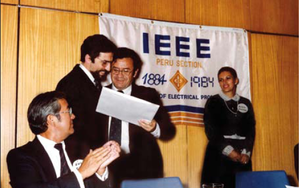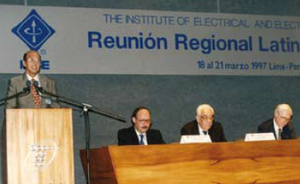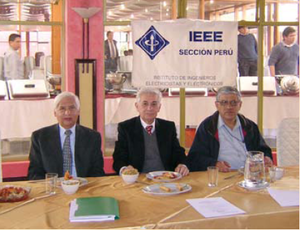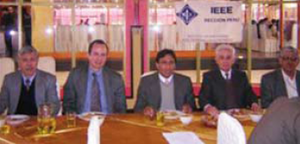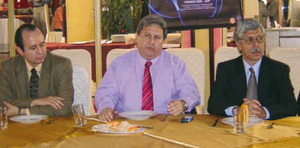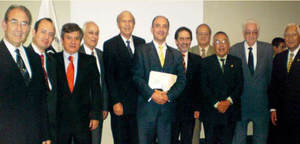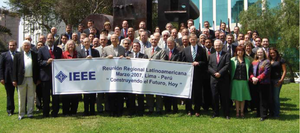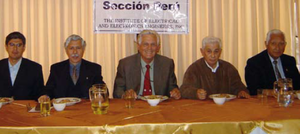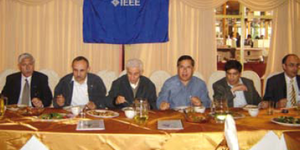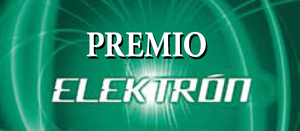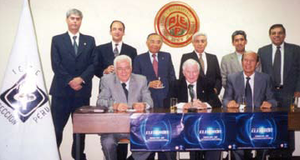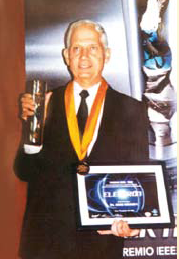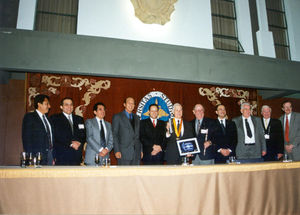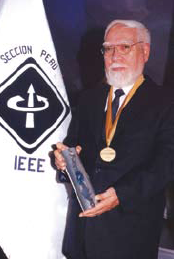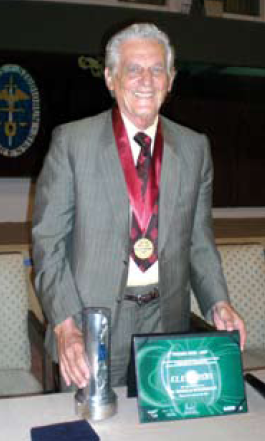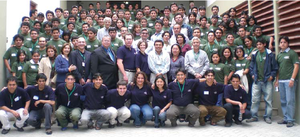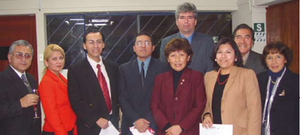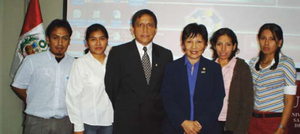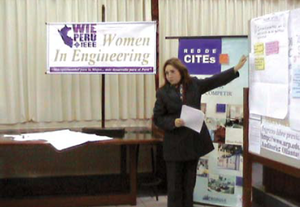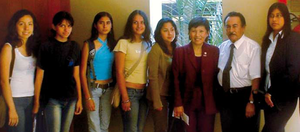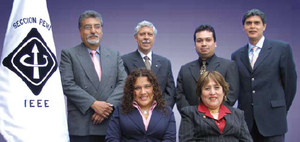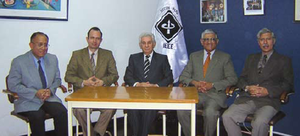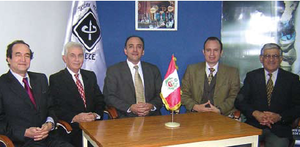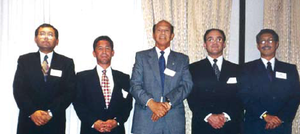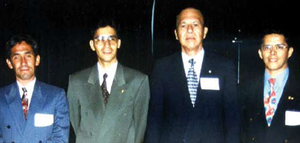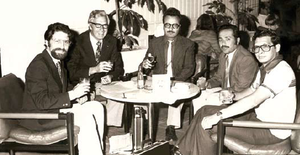IEEE Peru Section History
| IEEE Peru Section History | |
|---|---|
| Established date | 1967-11-02 |
| IEEE Region | 9 |
| IEEE Council | Andean |
| Geographic region | Peru |
| Region area | |
| Principal cities | |
| Home page | |
| ExpandList of Subsections in this Section | |
English
Introduction
This article summarized highlights of the IEEE Perú section’s history through its 40 years. It’s been prepared taking into account the work made by Guillermo Castillo on the Perú Section 25th anniversary, the information given by Carlos Becerra about Elektrón Award, the contribution of volunteers, professionals, students and the work made by IEEE Perú Section’s History Committee.
Historical Environment in the Beginning
IEEE Perú section establishment was approved during IEEE board of directors meeting, November 3, 1967. That day may be considered as the date of birth of Perú section.
The Institute of Electrical and Electronic Engineers (IEEE), was formed in 1963 by the fusion of the Institute of Radio Engineers (IRE) and American Institute of Electrical Engineer (AIEE), they both had a large tradition on knowledge diffusion of electrical and electronic engineering and radio too.
AIEE was established in 1884 and IRE in 1912.
In the early 1960s, while IEEE establishment was taking place, a tendency to worldwide activities centered in the USA was beginning. To achieve this target, were created regions 7, 8, 9 and 10, adding to those six existing regions in the USA.
Region 9´s creation, which was assigned to the enthusiastic direction of Guillermo J. Andrews, from Argentina, required creation of new centers, fundamental for activities: the sections. So, during 1967 and 1968 they were taking place in some countries of Latino America: some years before, Mexico and Argentina had their section organized inside the institute.
Prior Details to Establishment
The recently elected, Ing. Guillermo J. Andrews, Region 9 director, kept in touch with an old colleague in Perú, Ing. Gastón Wunenburger (dead), to promote and execute tasks in order to establish an IEEE section in Perú. Ing. Wunenburger had been general manager of those associated electrical companies (then Electro Lima), and professor of Electrotécnica at Universidad Nacional de Ingeniería, so he was respected and appreciated by both, professional and business communities: there’s no doubt, it was an excellent idea Andrews kept in touch with him. On the other hand, Dr. George R. Town, Dean of the school of engineering at Iowa State University, who was member of the IEEE board of directors, talked to Ing. Guillermo Castillo to contribute initiate an IEEE section in Perú and suggested he contact other members, a copy of this letter got in Guillermo Andrews´ hands, who immediately talked to Guillermo Castillo so that he would contact Ing. Wunenburger.
At that moment, the IEEE members were nearly twenty in Perú, so, Ing. Wunenburger asked Ing. Héctor Ayllón, Napoleón Gianoli and Juan Bartet promote and create the Perú section. Thus, they were already five members coordinating enthusiastically for establishing an IEEE section in Perú. And then occurred something anecdotic: Ing. César Pera (dead), who was an IEEE Perú section’s member, fully encouraged and by his own means, contacted to IEEE-New York, in order to find out the requirements for establishing an IEEE section in Perú. He was answered and sent forms to fill with signs, so that’s what he was doing alone until he finally met one of those founders previously mentioned, he joined them and continued on his looking for members, meeting them and collecting their signs.
In September 1967, all forms and applications were sent to the Regional Director asking the establishment of the section, it all finished when IEEE Board of Directors approved 3 November 1967. We weren’t enough in number to reach the minimum for establishing an office, at least forty members, but the board thought, in view of the circumstances, if doesn’t start to worldwide activities, it will be difficult increase the number of members, so they accepted and processed applications from regions with members less than 40, but under review evaluating their encourage and activities.
Ing. Wunenburger received, almost immediately, the news of Perú Section’s approval. In the next few days, Gastón Wunenburger, Napoleón Gianoli, César Pera, Guillermo Castillo and Mr. Dario Teodori, who wasn’t a member but a publisher from an electronic magazine, met at “Gianino” restaurant, Lima. At that meeting, the group had knowledge of the approval, so, the firsts activities was discussed and among them, the communication to other members and the first Board of Directors´ election.
The first election concluded in February 1968, and the recently Board of Directors elected was composed by:
Chair, Ing. Gastón Wunenburger Vice Chair, Ing. Napoleón Gianoli Secretary-Treasurer, Ing. Guillermo Castillo Committee member, Ing. César Pera Educational activities, Ing. Juan Bartet
IEEE Perú Section's Early Years
During 1968, at first the section must have been organized, also some other task like contacting to Regional Activities Board and learning the information and mailing systems of the IEEE had to be done. 3 or 4 conferences were held, some of them with participation of the Asociación Electrotécnica Peruana. By the end of the year, a complex Election Process was held, finally Ing. Napoleón Gianoli was elected as President.
In 1969, led by Napoleón Gianoli-Chair, Héctor Ayllón-Vice chair, Conrado Almaeida-Treasurer/Secretary and Guillermo Castillo-Committee member, some activities started in the Section meanwhile members were around forty. The well-known Reunion Meal, which takes place every fourth Wednesday’s month, were becoming more usual and almost always an invited lecturer shared opinions and answered question from attendees. By means of patience and effort, the section made possible to introduce this custom. In June, the first Region 9 Committee Meeting, which was comprised of section’s chairs, took place at Lima.
Some participants were:
Guillermo J. Andrews: Regional Director (Argentina) Francisco Hawley: México Section Chair. Saúl Arango: Colombia Section Chair. José R. Costa de Lacerda: Rio de Janeiro Section Chair. Carlos A. J. Lohman: São Paulo Section Chair. Napoleón Gianoli: Perú Section Chair.
Some others board of directors´ members also were present at the meeting. From previously mentioned: Hawley, Costa de Lacerda and Lohman were elected as Regional Directors.
Technical activities and meetings in the Sociedad de Ingenieros del Perú.
In 1970, the new elected Board of Directors was constituted by Héctor Ayllón-Chair, Guillermo, Castillo-Vice chair, Carlos Lee-Secretary/treasurer. As of that year, reunion meal has been stated as a monthly activity. The idea of short courses and lectures was taken into account but started coming: how much it will cost, who is going to be the lecturer, etc. in spite of everything, conferences continued up.
In 1971, the elected Board of Directors was constituted by Guillermo Castillo-Chair, Carlos Lee-Vice chair, Ruperto Jiménez-Secretary/Treasurer and Eduardo Zolezzi-Committee member. Héctor Ayllón was elected as Region 9 Vice chair. Reunion meal kept going well and for the first time Perú Section organized a short course on generalized electrical machine, presented by Ing. Juan Núñez Chávez, professor at UNI and Educational Activities Coordinator. The course was developed at Colegio de Ingenieros del Perú and lasted 2 weeks. Besides, it drew many attendees but very poor outcomes. Despite outcomes, the section received two important donations by CENTROMIN-PERÚ and associated enterprises, which helped to develop and hold many other activities.
In November 1971, the COPIMERA offered the opportunity to get together members from Region 9, especially those who were directors in their enterprises and sections. Meanwhile, there was a strong bond between the section and the Asociación Electrotécnica Peruana (AEP), the latter allowed use a part of its installations to the section for keeping files and holding the meetings. Also, members were growing in number, 70 members.
When 1972, the elected Board of Directors was constituted by Carlos Lee-Chair and Ruperto Jiménez-Vice chair. Short courses were developed and inevitable reunion meal still continued.
In 1973, the elected Board of Directors was constituted by Ruperto Jiménez-Chair, Augusto San Cristobal-Secretary/treasurer. The dynamic work and a growing number of achieved goals characterized this organization: short courses presented by lectures from USA (Francisco Paulo de Mello, among others). This was possible by making good use of opportunities and coordinating with Region 9 and the IEEE´s Educational Committee.
Because of the encourage and dynamic, the same Board of Directors was nominated for re-election in 1974, which supported from voting members, were elected later in 1976 and in 1977; Ing. Ruperto Jiménez was elected as Region 9 director, Guillermo Castillo-Vice Director, Augusto San Cristobal-Secretary/treasurer and Carlos Becerra-Technical Activities coordinator.
The Next Years
Years later, the section kept growing on: meal reunion was established definitely and short courses, too. In general, activities not only were increasing in number, but also quality.
In 1975, while Chair Augusto San Cristobal, sub-section OROYA had been created but years later it was deactivated.
IEEE Perú Section has been one of the most dynamic and encouraged among Region 9´s, because of the unconditional effort from members and the huge encourage from those who had the section under their responsibility.
Highlights
1976: Gastón Wunenburger, Perú Section Past President, was the first Region 9´s Ingeniero Eminente.
1978: Ing. José Valdez was elected as Ingeniero Eminente.
1982: when José Valdez was chair, the first IEEE Perú Student Branch was established at Universidad Nacional de Ingeniería.
Also, the Comité de Alta Tecnología and the Consejo Consultivo were organized; the latter was composed by past presidents.
An aggressive Campaign for increasing the number of members was planned, which was a completely goal.
1984: the Centennial of the IEEE was celebrated in every section throughout the world; at that moment, Ing. Julio Vento was the elected Chair.
The student branch office was opened at Universidad Nacional de Ingeniería.
Guillermo Castillo, Jack Vainstein and Julio Vento were recipients of the IEEE Centennial Medal.
1985: as of that year, newsletters were edited; a movie about “Los Cien Años de Progreso en la Electricidad”, a contribution from Region 9, was diffused in order to achieve IEEE´s targets.
1986: Lima hosted the Regional Meeting, at Crillón Hotel. Also, the IEEE handed over to recipient Ing. José Valdez the Larry K. Wilson International Award. The UNI Student Branch participated actively at this event.
1987: Ing. José Valdez was elected as IEEE Fellow and recipient of Centennial Medal.
1988: Russell Drew, IEEE president, visited Lima and signed the Collaboration Agreement between the IEEE Perú section and AEP. Russell came with Eric Herz-IEEE Executive Director, Carlos Rodríguez-R9 Director, and Robert Duggan-RAB Vice President.
1989: the UNMSM Student Branch was established because of students’ effort, headed by Angel Sabastizagal, from Electronic Faculty and supported by Manuel Sánchez-Educational Activities director, and the UNI Student Branch.
1991: The Peru Section and the CIP teamed to organize 2 forums, fostering private investment on electricity and telecommunication sectors. The IEEE Communications Society was created: Carlos Bisso-Chair, Glenda Matienzo-Vice Chair.
1992: On 6 November, the celebration for the 25th anniversary took place at Crillón Hotel.
1993: The Ricardo Palma Student Branch was established formally. At the Regional Meeting, Acapulco, the Perú Section received the third place award for The Best Management of the R9. At that moment, Carlos Bisso was heading the section.
In August, the CIP and the section co-sponsored the III Forum Fostering the Private Investment in Telecommunications Sector.
1994: The first INTERCON was organized by URP Student Branch and sponsored by Perú Section. Luis Galloso was the URP Student Branch President.
1995: The Regional Director honored the Perú Section for its outstanding work in 1994. The outcomes placed our work among the best. They had good impression for reunion meals and newsletters. It was recognized the creation of 2 new Student branches and the success for the INTERCON-94. The new Student Branch office at the Universidad de Piura was approved under the direction of Mr. Eliodoro Carrera.
1996: Workshop for R9´s Student Leaders was held in Panamá. The Peruvian delegation was huge in number, among those Luis Guzmán-Student Activities Committee Chair, César Merino-Universidad de Lima, and David Guerrero-URP.
Ing. Carlos Silva received the Consejero Ejemplar de Latinoamérica Award and the PUCP Student Branch was honored as a Model Branch in Latinoamérica.
1997: Mario Calmet took office as IEEE Perú Section Chair, and the Regional Meeting took place in Lima, at Sheraton Hotel.
For the first time Presidents, Past-presidents and Student Leaders from R9 gathered in the Regional Meeting, and then it was named as La Reunión de Tres Generaciones.
The meeting drew 102 IEEE volunteer leaders. The Section received different awards
- For the high growth in Latinoamérica.
- “El Mejor Logro en 1996” Award, to the INTERCON 1996.
- “Rama Ejemplar en Latinoamérica” Award, PUCP Student Branch.
- “Ingeniero Eminente” Award, to Jack Vainstein P., Perú Section´s Senior Member; for his outstanding qualifications and contribution to institutional and professional field.
- Ing. Juan Mendoza is the recipient of the RAB Achievement Award.
1998: the Perú Section, the AEP and the CDL-CIP held the “II foro Sobre Ley de Concesiones Eléctricas”.
The Universidad Nacional del Centro Student Branch is approved.
The IEEE gave the Recognize Education Program (REP) to programs for Electrical Engineering and Mechanical Engineering from Universidad Nacional San Antonio Abad, Cusco.
The IEEE Perú Foundation was formed by IEEE Perú past presidents, which is meant to support technical meetings and the development of other new Student Branches.
PUCP Student Branch received the Platinum Award to the first place in the Worldwide Competition for Web Sites; UNMSM Student Branch received the second place and the Silver Award.
1999: Ing. Tito Inope is distinguished as Ingeniero Eminente at Regional Meeting. Ing. José Valdez is upgrade to Life Fellow.
According to the IEEE membership report, 31 January, Perú Section established a record, more than 1000 active members: 628 student members and 374 professional members. Ing. Mario Calmet is elected as R9´s Awards and Recognition Chair.
2000: Juan Mendoza is elected as IEEE Distinguished Volunteer, and Ing. Miguel Becerra Fernández is honored as IEEE Ingeniero Eminente.
Representatives of the IEEE Perú section: Ing. José Valdez Calle, Ing. César Chamochumbi, Ing. Jack Vainstein, Ing. Héctor R. Ayllón, Ing. Mario Calmet, Ing. Carlos Becerra, Ing. Guillermo Castillo, and Ing. Gotardo A. Piazza are recipients of the IEEE Third Millennium Medal. This award is given to those members who have made outstanding contributions in pro to the office.
2001: the first Elektrón Award is given to recipient Dr. Jorge Heraud in the VIII INTERCON, organized at Universidad de Piura.
The Universidad San Martín de Porres Student Branch was created.
2002: The IEEE Main Office recognized some Student Branches from different universities: UNMSM, Universidad Nacional del Callao, Universidad Nacional San Agustín de Arequipa, and Universidad Nacional Pedro Ruiz Gallo de Chiclayo.
2003: The Perú Section and the AEP joined to organize the II Elektrón Award 2003, which was given to recipient Ing. Amadeo Prado Benítez.
On 20 August, the Instituto de la Calidad para la Acreditación de las Carreras de Ingeniería y Tecnología (ICACIT) is created in order to start accreditation for technical and professional careers. The ICACIT´s founder members are:
- Academia Peruana de la Ingeniería.
- Asociación Electrotécnica Peruana.
- Colegio de Ingenieros del Perú.
- CONFIEP.
- IEEE Perú Section.
- Sociedad Peruana de Software.
The Section put forward Enrique Alvarez Rodrich as a candidate for Regional Elected Director 2004.
Mario Calmet Agnelli is nominated to the Ingeniero Eminente Award for his encouraged dedication and huge contribution to the Section.
José Coronado, student, received the Larry K. Wilson Award, for his outstanding work as X INTERCON Committee Chair, supported by the USMP Student Branch.
2004: The Gallery of Board of Directors, which is placed into the office, is inaugurated beginning from 2001 BOD.
At the 2004 Regional Meeting, Buenos Aires, Mario Calmet Agnelli received the Ingeniero Eminente Award.
From 11 to 14 March, the R9´s Power Society Congress was held in Buenos Aires. The congress took place at Hotel Crowne Plaza Panamericano which drew 29 attendees, as Regional PES Directors as Power Chapter Directors. César Chamochumbi, PES Chair, represented the Perú Section.
From 5 to 7 May, Tom Cain, IEEE Past Chair and international expert in accreditation in the fields of electrical, electronic and computational engineering, visited Perú.
2005: The first Past Presidents´ Reunion Meal. R9´s Board of Directors was invited and also the HQ, the latter had visited Lima for the inauguration of the XII INTERCON at UTP. The III Elektrón Award went to Ing. Juan Bartet Rosas. Ing. Enrique Alvarez Rodrich is elected as 2006-2007 Regional Director-Elect.
2006: The Second Past Presidents´ Reunion Meal was carried out. Meetings, in which distinguished members participated, among them José Valdez, Enrique Alvarez, and Carlos Bisso, were held. There were two meetings about strategic management.
2007: Lima hosted the R9 Regional Meeting. The latter took place at Los Delfines Hotel from 7 to 10 March; Walter Fegan-Past President, and César Chamochumbi-Perú Section Chair, headed the team and this could be possible with the help from Enrique Alvarez Rodrich and the whole Perú Section BOD, Student Branches and the R9 Executive Committee, too.
While RR, in a session for the Consejo Andino, the Perú was elected for hosting the ANDESCON 2008. Also, César Chamochumbi-Perú Section Chair- is elected as Consejo Andino Vice-President.
The newsletters are designed in a colorful modern format. The Circuits and Systems Chapter is created, on the head, Ing. Carlos Silva.
The new web site is created, with a friendly and modern design, so that all past activities could be uploaded, besides to spread coming activities and recent events. The web site is: www.ieeeperu.org.
Mr. Jorge Tejada is elected to receive the 2007 Consejero Sobresaliente Award, as a USMP Student Branch Adviser.
Víctor Pacora, student at the UNI, is elected for R9`s Student Activities Committee to receive the Larry K. Wilson Award for his outstanding and admirable effort in benefit as the Student Branches as the Section Office.
On Monday 6, August, the Section and the AEP worked together in order to carry out the IV Elektrón Award, during the XIV INTERCON, held at the Universidad de Piura. This time, Mr. Ronald Woodman is the recipient of the Elektrón award.
The Communication Society Chapter, headed by Ing. Jorge Reyna is elected as the best chapter in Latinoamérica for the great number of members.
The USMP Student Branch is elected by the R9 as the Model Student Branch in the R9.
Begins the EAB Project named TISP (Teacher in Service Program), it is intended to foster in high school students the idea of Science and Technology. The Student Branches work on visiting and training teachers of math and science.
Events of Great Importance the Section was At
ABET Perú e ICACIT
The Perú Section had made an accreditation project for engineering careers: ABET Perú.
ABET (Accreditation Board for Engineering and Technology) Perú is meant to improve the quality of engineering professionals, which contributes to create a market more competitive.
The ABET Perú Committee invited leaders from academic and professional institutions, publics and privates, in order to form the ABET Peru’s Permanent Council. The latter is equivalent to what Americans call Board of Trustees; i.e. a high-quality team that approve institutions that demonstrate to be reliable and responsible.
ABET (Accreditation Board for Engineering and Technology), is an institution from USA in which the IEEE participates. The ABET was installed for colleges and universities to develop a mechanism which permits evaluate if they are able to adapt to a fast changing of technology. We can see it clearly in the fields of electricity, electronics, and computation.
The IEEE EAB (IEEE Education Activities Board), supports ABET at those fields. The strong tie is to the point Ing. Jerry Yeargan, ABET past president, was a distinguished IEEE member.
Since 2000 our contacting with EAB has been crystallizing in a plan elaborated by the Perú Section, in order to open an ABET office in Perú, supported by the Section. Tom Cain was named by the EAB to make links in Perú.
A summarized list of the trajectory of Tom Cain is next:
- ABET (Accreditation Board for Engineering and Technology), 1983.
- 1989 Program Evaluator for Computer Science and Engineering, and Electrical engineering.
- IEEE 1988-1989 Computer Sciences Accreditation Board President.
- IEEE 1993 Publications Board Nominations Committee Chairman.
- IEEE 1993 Fellow.
- IEEE 1995 Compensation Committee Chairman.
- IEEE 1995 president of the Board of Directors.
- IEEE 1994-1999 Foundation Board Director.
- IEEE 2000-2001 Awards Board Director.
- IEEE 1999 Strategic Planning Committee Chairman.
- IEEE 2000 Millennium Medal.
- University of Pittsburgh Professor of Electrical Engineering.
- Engineering University of Pittsburgh Professor of Computer Engineering.
The ABET Perú was established on 20 April, 2000, at CIP, address. Arequipa Av. 4947, Miraflores. The Foundation Certificate was signed; as the statutes as the Board were approved. Tom Cain made his speech called: The Importance of ABET in the Economic and Social Development and Experiences within and outside USA”.
ABET Perú is the beginning of the now known ICACIT (Instituto de Calidad y Acreditación de Programas de Computación, Ingeniería y Tecnología / www.icacit.org.pe).
Elektron Awards
]
This award is given for an outstanding contribution to the national well-being in the fields of electricity, electronics, informatics, and communications technologies.
In March, 1999, at the IEEE Foundation Meeting, it was discussed the idea of holding awards between the IEEE and Institutions in each country, so, in July, Perú, Japan and Germany are chosen to run the pilot program sponsored by the IEEE.
In September, 1999, the section had talks with institutions and created a committee to organize the award led by Ing. José Valdez. After several monthly meetings, the IEEE Perú Section and the AEP signed an agreement and together started developing statutes and requirements for the award.
In August, 2000, the IEEE approved the agreement and named a Permanent Council and the Executive Committee, integrated by representatives from each institution, who would carry out the organization and the very award IEEE-AEP.
The representative started the work as soon as it was possible and dated the first award to be delivered in August, 2001, coinciding with the INTERCON.
They decided to call the award by the name of ELEKTRÓN, as a common name in use within each career; by means of a competition for the award’s design, Mariem Valdez is elected the winner among others artists.
1999-2000 Organizing Award Committee
- Ing. José Valdez-President.
- Ing. Antonio Blanco- National Dean of the CIP.
- Ing. Mario Valdivia- CIP/CIME Mechanic-Electrical Engineering Chapter.
- Ing. Víctor Chávez- CIP/CIE.
- Ing. César Bazán- CIP/CIE Electronic Engineering Chapter.
- Ing. Jorge Ratto- AEP.
- Ing. Nestor Vargas- AEP.
- Ing. Manuel Zelada- AEP.
- Ing. Eduardo Ismodes- IEEE Perú Section Chair.
- Ing. Enrique Alvarez- IEEE Perú Section vice Chair.
- Ing. Mario Calmet- IEEE Perú Section Past President.
The 2001 Elekron Award
On 11 January, 2001, the first ELECKTRÓN Award is elected officially during the AEP Annual Meeting and announced by Ted Hissey. On 12 January, it was held the first press conference at the Pardo Miraflores Hotel, beginning the diffusion of the award and inviting to present candidates.
Many institutions -educational and professional enterprises- sent their representatives who were evaluated by the panel of judges, formed by five members with a brilliant outstanding professional trajectory. Dr. Jorge Heraud was the first recipient of the prize.
On 7 August, 2001, during the VIII INTERCON inauguration in the city of Piura, the award was given to Dr. Heraud; it consisted of a certificate, a medal and a trophy.
At this activity, Joel Snider-2001 IEEE President, Troy Nagle- IEEE Awards and Recognition Committee Chair, and Ted Hissey-IEEE Director, were invited.
The work and effort in the organization of the award became in good commentaries coming from the IEEE, because of it was the first developed in world, besides it was recommended to take this work as a prototype to others countries.
Consultants:
- Ing. José Valdez- Organizing Committee President.
- Ing. Eduardo Ismodes- 1999 IEEE Perú Section.
- Ing. Néstor Vargas- AEP Chair.
- Ing. Enrique Alvarez- 2000 IEEE Perú Section Vice-Chair.
Permanent Committee:
- Ing. Mario Calmet- President.
- Ing. Ted Hissey-IEEE Award Board.
- Dr. Carlos Romero-AEP.
- Ing. Tito Inope-AEP.
- Sr. Jorge Feliú-IEEE Perú Section.
- Ing. Carlos Becerra- IEEE Perú Section.
- Sr. Carlos Ausejo- Advertising consultant.
Executive Committee:
- Dr. Antonio Morán- President.
- Ing. Pedro Martínez- AEP.
- Ing. Manuel Zelada- AEP.
Guests:
- Joel Snider, 2001 IEEE Chair.
- Troy Nagle, IEEE Awards and Recognition Committee Chair.
- Ted Hissey, IEEE Director.
2001 Panel of Judges:
- Ing. Juan Inchaústegui, mechanical-electric engineer, President at the Academia Nacional de Ingeniería, TECSUP Chair and Minister of Industry.
- Ing. Guillermo Castillo, mechanical-electric engineer. PROTECNA Chair; ETECEN Chair, and past President of the Tarifas Eléctricas Committee.
- Francisco Sagasti, Economist. Strategy on Planning Director, Banco Mundial; Proyecto Perú Founder.
- Benjamín Marticorena, Physicist PhD; Senior Consultant, Naciones Unidas; 2002 CONCYTEC President.
- Jack Vainstein, mechanical-electric engineer. IEEE Ingeniero Eminente. J. Vainstein Ingenieros Founder.
Award:
- VIII INTERCON inauguration at the Universidad de Piura, 7 August, 2001.
- The award goes to Dr. Jorge Heraud Pérez, “ For his extraordinary effort and contribution improving the Peruvian society through promoting and developing technology and science”
Sponsors:
- IEEE Foundation
The 2003 Elektron Award
After finishing the activities of the first prize, coordination didn’t stop, so, on 17 December, 2001, is elected the Permanent Committee and the Executive Committee for the 2003 ELEKTRÓN Award, with the participation of IEEE´s and AEP´s members.
On 6 August, 2002, the news about the ELEKTRÓN Award is launched by Ted Hissey, IEEE Director, during the 2002 INTERCON inauguration, held into the Fort Real Felipe, Callao.
This time, it was necessary to find sponsors to cover outcomes for the event. Two huge industries in the field of electricity cooperated unselfishly: ABB Perú and INDECO.
As an adequate promotion of the award into universities, industries and institutions, as the prestige got in the first deliver, could harvest 15 candidates for the second prize.
The 2003 Panel of Judges, formed by 6 distinguished professionals, had a delicate labor to choose the recipient of the award.
Finally, Ing. Amadeo Prado Benítez is elected and received: the award from Hugo Rudnick-IEEE Latinoamérica Director; the certificate from Evangelina Micheli-Tzanaku- Awards and Recognition Committee Chair; and the medal from Tom Cain-IEEE Past President.
Miembros Natos:
- Ing. Alejandro Lengua- AEP Chair.
- Ing. Tito Inope- IEEE Perú Section Chair.
- Ing. José Valdez- AEP-IEEE Perú Section Consultant Committee Chair.
- Ing. Tom Cain- IEEE Awards and Recognition Chair.
Permanent Committee:
- Ing. Mario Calmet- President.
- Sr. Jorge Feliú - IEEE Perú Section-Vice President.
- Dr. Carlos Romero-AEP.
- Ing. Tito Inope-AEP.
- Ing. Carlos Becerra- AEP
- Ing. Carlos Silva-IEEE
- Sr. Carlos Ausejo-Advertising consultant.
Sponsors:
- ABB Perú.
- INDECO Peruana.
Executive Committee:
- Dr. Antonio Morán- President.
- Ing. José Barbe- AEP.
- Ing. Enrique Alvarez-IEEE
- Ing. Manuel Zelada- AEP.
Guests:
- Hugo Rudnick, IEEE Latinoamérica Chair.
- Evangelina Micheli-Tzanaku, IEEE Awards and Recognition Committee Chair.
- Tom Cain, IEEE Past President.
Award:
- X INTERCON inauguration at the Universidad San Martín de Porres, 19 August, 2003.
- Ing. Amadeo Prado B.,“ For his outstanding work and contribution to the national well-being through in the fields of Electricity, Electronic, and computation science”
2003 Panel of Judges:
- Ing. Juan Inchaústegui, mechanical-electric engineer, TECSUP Chair.
- Ing. Guillermo Castillo, mechanical-electric engineer. ELECTROPERÚ Chair.
- Ing. Jorge Heraud, Recipient of the 2001 ELEKTRÓN Award, professor at PUCP.
- Benjamín Marticorena, CONCYTEC President.
- Jack Vainstein, mechanical-electric engineer. IEEE Ingeniero Eminente.
- Héctor Gallegos, president at Gallegos-Casabone-Arango Ingenieros Civiles.
The 2005 Elektron Award
The already structured organization kept working on renewing representatives of the Permanent Council and the Executive Committee, too. The new board was announced officially during the AEP Anniversary Meeting, 13 January, 2005.
This time, REP, Red de Energía del Perú, sponsored the prize and Ing. Carlos Ariel Naranjo, REP´s Manager, participated in the deliver of the award.
A new web site is launched, where one can find the history of the prize, requirements, rules, recipients, and the inscription form.
Likewise, the use of emails and the AEP´s and Section’s data base for spreading the prize’s news, also, the email account is: elektron@ieee.org.
The new 2005 Panel of Judges, formed by 7 members, evaluated 6 candidates, deciding unanimously to Juan Bartet Rosas as the recipient of the 2005 ELEKTRÓN Award, for his pioneering contributions in the fields of education and research, developing the electronic engineering in Perú during 50 years of professional career.
The deliver of the prize took place on 8 August, 2005, at the Universidad Tecnológica Peruana, during the XII INTERCON inauguration.
This activity drew the more important representatives of the IEEE, among them: Cleon Anderson-2005 IEEE Chair, Michael Lightner-2006 IEEE Chair-elect, Francisco Martínez- IEEE R9 Director, and Ted Hissey-IEEE Director.
Award:
- XII INTERCON inauguration at the Universidad Tecnológica del Perú, 8 August, 2005, Lima.
- Ing. Juan Bartet Rosas “For his pioneering contributions in the fields of education and research, developing the electronic engineering in Perú during 50 years of professional career”; presented by the PUCP.
Miembros Natos:
- Ing. Alejandro Lengua Ulloa- 2003 AEP Chair.
- Ing. Tito Inope- 2004 IEEE Perú Section Chair.
- Ing. Walter Fegan Justo- IEEE Perú Section Chair.
- Ing. José Valdez- AEP-IEEE Perú Section Consultant Committee Chair.
- Ing. Jesús Beoutis Ledesma- 2004 AEP Chair.
- Ing. Pedro Martínez Torres Lara- 2005 AEP Chair.
2005 Permanent Committee:
- Ing. Carlos Becerra- AEP President (4 years).
- Ing. Mario Calmet Agnelli- AEP (2 years).
- Dr. Morán Cárdenas- IEEE Perú Section (2 years).
- Ing. Enrique Alvarez Rodrich- IEEE Perú Section (4 years).
- Dr. Carlos Silva Cárdenas- IEEE Peru Section (6 years).
- Ing. José Barbe Pflucker- AEP (6 years).
Sponsors:
- REP Red de Energía del Perú
Executive Committee:
- Dr. Carlos Silva Cárdenas- President
- Dr. Antonio Morán Cárdenas
- Ing. José Barbe Pflucker
Guests:
- Cleon Anderson- 2005 IEEE Chair
- Michael Lightner-2006 IEEE Chair-elect
- Francisco Martínez-R9 Director.
- Ted Hissey-IEEE Director.
- Renato Céspedes- IEEE RAB Chair.
2005 Panel of Judges:
- Ing. Juan Inchaústegui, mechanical-electric engineer, TECSUP Chair.
- Ing. Guillermo Castillo, mechanical-electric engineer. ELECTROPERÚ Chair.
- Dr. Modesto Montoya Zavaleta- IPEN President.
- Ing. Amadeo Prado Benítez, Recipient of the 2003 ELEKTRÓN Award.
- Ing. Emilio Navarro Castañeda- Soldadoras Andinas S.A, President.
- Jack Vainstein, mechanical-electric engineer. IEEE Ingeniero Eminente.
- Ing. Carlos Romero Sanjinés- MTC Consultant.
The 2007 Elektron Award
Siemens Perú was the new brand sponsor of the prize. The Judges decided to deliver the 2007 ELEKTRÓN Award to Dr. Ronald Woodman.
The award was given during the XIV INTERCON inauguration, 6 August, 2007, at the Universidad de Piura, Piura.
This activity drew representatives from the IEEE: Leah Jamieson-IEEE Chair, Moshe Kam- IEEE EAB Vice chair, Richard Gorham-IEEE EAB Director, and Enrique Alvarez Rodrich- IEEE R9 Director-Elect.
Award
- XIV INTERCON inauguration at the Universidad de Piura, 6 August, 2007, Piura.
Sponsors:
- Siemens Perú.
Guests:
- Leah Jamieson-IEEE Chair
- Moshe Kam- IEEE EAB Vice chair
- Richard Gorham-IEEE EAB Director.
- Enrique Alvarez Rodrich-IEEE R9 Director-Elect.
Miembros Natos:
- Ing. César Chamochumbi García- 2007 IEEE Perú Section Chair.
- Ing. Franco Veliz- 2005 AEP Chair.
- Ing. Walter Fegan Justo- 2006 IEEE Perú Section Chair.
- Ing. José Valdez- AEP-IEEE Perú Section Consultant Committee Chair.
- Ing. Jesús Beoutis Ledesma- 2004 AEP Chair.
2007 Permanent Committee:
- Ing. Carlos Becerra- AEP President.
- Ing. Guillermo Castillo-AEP
- Mr. Carlos Q. Ausejo- Advertising consultant.
- Ing. Rodolfo Sakata - IEEE Perú Section.
- Ing. Enrique Alvarez Rodrich- IEEE Perú Section.
- Dr. Carlos Silva Cárdenas- IEEE Peru Section.
- Ing. José Barbe Pflucker- AEP.
Executive Committee
- Dr. Carlos Silva Cárdenas- President
- Ing. José Barbe Pflucker
Future Engineers in Action
INTERCON
The IEEE holds worldwide activities, but just few on Latin America, so, why don’t we hold one in Perú which gathers students and professionals.
The author of this great idea, Luis Guzmán Galloso, met 5 friends: Luis Aliaga, Guido Frabotti, Carlos Valverde, David Guerrero, and Miguel Angel del Pozo. Galloso told them his idea and suggested to work on the project.
In 1993, these young men flew and took their projects at the XIII INGELECTRA, Valdivia, Chile.
In October, 1993, they arrived at Valdivia to present their projects and at the closing ceremony, a funny thing happened: Luis Guzmán was called, as representative of the Peruvian delegation, to give the closing speech, it was a hopeful and friendly message to promote the development in both countries, but at the end he said: ”Bueno amigos, los esperamos en junio de 1994 en el Primer Congreso Sudamericano de Ingeniería Electrónica en la ciudad de Lima”. Actually, we know it was held from 20 to 23 September, 1994, and took the name of INTERCON. As the closing ceremony finished, everyone came over to ask about what was that, also the Peruvian delegation, they watched face to face, and finally said: ok let’s do it.
Once back at Lima, in November, at that year, they developed a first preliminary plan, also formed a widely and increasing team constituted by volunteers from the student branches.
In January, 1994, as Miguel Becerra took office as Perú Section Chair, the plan is presented at the Universidad Ricardo Palma and the IEEE Perú Section, which checked it up and approved it. They work on a strategy to join others student branches at the work meetings and so each could contribute. The URP Student Branch headed the project and on Saturdays, from 10 to 12 pm, they met with all representatives from other branches. Each meeting was held at different universities. At that moment, there were a few branches throughout the country: UNI, UNMSM, and URP.
The activity was taking shape at least on the paper; it was estimated and planned to draw 250 attendees.
In February, 1994, the project was almost ready. The 1994 INTERCON would be constituted by three main parts: conferences, project competition, and industrial exposition (technological fair). Then it was proposed to add a new part: to organize a SPAC in the frame of the activity, besides it would be the first on South America.
After having coordination with the Perú Section, it was set up a journey promotion plan, and then some new branches were established: the UPAO Student Branch in Trujillo; the UNSA Student Branch in Arequipa; the PUCP Student Branch in Lima. Some others universities kept in touch: Pedro Ruiz Gallo, Universidad del Centro, Universidad Privada de Tacna, etc.
In late march, Ing. José Valdez Calle is the key for the project because of his outstanding trajectory at the IEEE and the strong links with enterprises. Ing. José Valdez was invited to be the project’s consultant, so, they asked him to meet them. A funny thing happened, at that moment Ing. Valdez didn’t know them: Miss Margarita, his assistant, on behalf of him, said that the meeting would be at July’s end, but it would be late by then. They insisted to the point he finally met them, and as they showed the project, Ing. Valdez was exciting about the process and he became a permanent co-operator and the key that would open many doors.
Luis Gusmán, as the Project’s leader, felt a huge responsibility to have all on the right track and much more than expectation from people. He decided to fly to the SUPERCOMM ´94, New Orleans, as we know this event launches the newest technologies and is held by the IEEE, under rigorous organization standards and rules. The objectives were, as participate at the lectures as meet American lecturers that could speak about modern technology and check out the details about the organization and how they carry it out till the end.
When he was back, the organization could commit enterprises like “Lucent Technologies”, “ALCATEL”, AT&T, etc. These enterprises not only sent granted lecturers, but also were expositors during the INTERCON at the Technology showroom, called TELCOM.
After this know-how, one thing mattered: to draw an important number of attendees. It was amazing to see not only interested students, but also professionals. Ing. Mario Calmet was the first professional on the list.
A number of 950 attendees among students, professionals, and guests, arrived at 7:30 pm to the inauguration ceremony, the room was full of more than 1500 people. Then the TELCON `94 was inaugurated and the INTERCON began.
Finally, it might be said the INTERCON `94 left its track on the IEEE Perú section. From then till now, this activity became as a tool for the development of the office, starting the establishment of new Student Branches, new projects, raising the number of memberships and generating a synergy which till now move the engine not only the Perú Section, but also Latin America.
After this great activity, different Student Branches keep working on hard each year, with their characterized encouragement and responsibility.
- INTERCON 1994: Universidad Ricardo Palma-Lima
- INTERCON 1995: Pontificia Universidad Católica del Perú-Lima
- INTERCON 1996: Universidad Particular Antenor Orrego-Trujillo
- INTERCON 1997: Universidad Nacional San Augustín-Arequipa
- INTERCON 1998: Universidad Privada de Tacna-Tacna
- INTERCON 1999: Universidad Nacional de Ingeniería-Lima
- INTERCON 2000: Universidad Peruana de Ciencias Aplicadas-Lima
- INTERCON 2001: Universidad de Piura-Piura
- INTERCON 2002: Universidad Nacional del Callao-Lima
- INTERCON 2003: Universidad San Martín de Porres-Lima
- INTERCON 2004: Universidad Nacional Pedro Ruiz Gallo-Chiclayo
- INTERCON 2005: Universidad Tecnológica del Perú-Lima
- INTERCON 2006: Universidad Nacional del Callao
- INTERCON 2007: Universidad de Piura-Piura
- INTERCON 2008: Universidad Privada Antenor Orrego-Trujillo
- INTERCON 2009: Universidad Nacional San Agustin-Arequipa
- INTERCON 2010: Universidad Nacional del Altiplano-Puno
- INTERCON 2011: Universidad Nacional de Ingenieria-Lima
National Leaders Workshop
Backgrounds
The idea of the 21st century engineer represents a changed paradigm: today’s engineers must promote its own creation; not only must chase a job, but also must create it. This must be a worldwide leader, a visionary, enterprising, and committed engineer, to its social environment and for the social well-being. (Simposio Ingeniería Para las Américas- Final Report http://www.oest.oas.org/engineering/espanol/documentos/Informe_Final_ESP.pdf).
The IEEE, the biggest non-profit institution on the globe, has more than 350000 engineers who have as mission: to foster activities in engineering like creation, development, integration, exchanging, and the application of knowledge in the fields of electro-technology and communications technology for the benefit of humanity. (http://www.ieee.org/web/aboutus/visionmission.htm).
Introduction
Working on our institutional mission and having in mind the recommendations of the Simposio Ingeniería para las Américas, the IEEE Perú Section promotes the Taller Nacional de Líderes IEEE Sección Perú, on the importance of contribute to form student leaders, because they will become into active professionals in the industry and academic fields, also in professional associations, and governmental agency in a short term.
The IEEE Perú Section named the Student Activities Committee (SAC), which have the task of following the recommendations to develop the “Taller Nacional de Líderes IEEE Sección Perú”, and execution is delegated to one branch of the country elected by an annual competition.
The Taller Nacional de Líderes IEEE Sección Perú draws 4 students from each IEEE Student Branch installed at 16 universities. This not excludes groups who want to open an office at their universities.
Targets and commitments
The Taller Nacional de Líderes IEEE Sección Perú has as mission to form better professionals that are identified to their social environment and have a positive vision of the future on the base of the social capacity. The following objectives were planned:
- Show the frame of practice of engineering in the national and international context.
- Offer the link to worldwide engineers: a visionary, enterprising, committed and leader engineer to its social environment and for the social well-being.
- Present how professional organizations, like IEEE, help to improve professionals by giving tools.
- Finishing the workshop Taller Nacional de Líderes IEEE Sección Perú, attendees must sign a letter in which they commit to:
- Work on a workshop with the same subjects into their academic community with their geographical resources in a 1 year term.
- Show the progress and outcomes from the previous letter at the IEEE Student Branches National Meeting, organized by the SB at that year.
Subjects
The Taller Nacional de Líderes IEEE Sección Perú is a structured event where students have contact with experienced engineers in a sort of themes such as:
- The engineering practice context.
- Science, technology, innovation and engineering (references: OEA, CONCYTEC, IEEE).
- Accreditation for a sound formation in the fields of Science and Engineering (References: ABET, ICACIT).
- Professional ethics and social responsibility.
- Growth and professional management.
- Engineers in policy.
- Professional society’s role.
- Professional development’s resources.
- Extra skills such as: communications, teamwork, practice of ethical principles, and the capacity of a continuous learning (references: IEEE, OEA http://www.science.oas.org/ministerial/inge/lueny_skillsforthemillenium_final.pdf)
- Organization and management of a Student Branch.
- Benefits, competitions and awards the IEEE deliver to members.
- The network of professionals around the globe.
Women in Engineering
The Beginning
In 2004, we created the first WIE into the country at the Universidad Ricardo Palma and Margarita Domínguez took office as president; the whole group asked for my advices. For all our held activities, we received the IEEE WIE Recognition, signed by Mary Ellen Randall, as the 2004 WIE winner.
When the Section began to foster female participation into the IEEE, on 6 September, 2005, from Walter Fegan Justo-Section Chair, I received the challenge to multiply the WIE in each Student Branch and to create a Professional Group into the office.
The first task we gave priority was to constitute the Professional Group. At that moment, just one person was a WIE member, so we started to encourage professionals from Science and Technology to register at the same time in both, IEEE and WIE. Finally the group was formed by 8 members, two more than the minimum. The first activity was to organize a conference: “La Mujer Profesional de Ciencias e Ingeniería en el Desarrollo del País”, in March, 2006, where Ing. Fegan signed the requirement of constitution of the WIE Professional Group.
Officially, the WIE was approved on 2 December, 2006, with the letter coming from Cecelia Jankowsky-Managing Director Regional Activities, on behalf of Mr. Pedro Ray-IEEE Regional Activities Vice President.
The Organization
At the first meeting, 4 April, 2007, we held the Board of Directors` election, being formed as follows:
Chair: María Chiok Guerra. Vice-Chair: Mercedes Inés Carazo de Cabellos. Secretary: Alicia Chiok G. de Taipe. Treasurer: Virginia Vera Pomalaza. Projects Committee: Silvia Castro Burgos. Membership Committee: Enrique Alvarez Rodrich. Conference Committee: Silvia Campos Benites. Student Activities: Juana Segura González.
Missions
The Perú WIE is formed by IEEE members: students and professional, men and women, all interested on fostering the participation of women in Science and Technology, especially in engineering.
The WIE Professional Group has as main target: to support women as in her professional development, from applicant, student to become a successful professional, as to plan her role into the community through projects in order to reduce the digital gap.
The mission of WIE is: the developing of activities and programs to foster the applying and standing of women in Science and Technology careers, especially in engineering, highlighting her participation.
Achievements
- Supporting and advising to constitute a WIE Group at the Universidad Privada Antenor Orrego, February, 2006, Trujillo; conference: “Competitividad y Tecnología”; officially introduction of the Perú Section’s WIE.
- The WIE groups at the Universidad Garcilazo de la Vega and San Luis Gonzaga, Ica, are in coordination to be formed.
- The IEEE/WIE bulletin has the next themes: What’s the IEEE?; Membership, Missions, Advantages , and Targets of the IEEE; What’s the Women in Engineering Group-WIE?; Missions and Targets; Perú Section’s WIE; WIE in Student Branches; Information & Applying.
- Seminar: “La Mujer Profesional de Ciencias e Ingeniería en el Desarrollo del País”; the IEEE and the CITDEL (Centro de Tecnologías, Desarrollo Empresarial y Liderazgo), at the Universidad Ricardo Palma, held the conference to make reflection about the participation of Peruvian women into Science and Engineering careers.
- That event was organized to celebrate the Women Day. The conference was held on 24 March, 2006.
- The conferences were: “Importancia de las Ciencias e Ingeniería en el Desarrollo del País” by Ing. Enrique Alvarez; “Enfoque de Genero y Desarrollo del País” by Mg. María Eugenia Mansilla; “El Rol de la Mujer en la Innovación Tecnológica” by Mg. Mercedes Inés Carazo; “Grupo IEEE WIE: Women in Engineering” by Mg. María Chiok Guerra.
- Conference held at the Universidad Femenina about the WIE Group: “La influencia del IEEE en la Ingeniería de Sistemas”, commemorating the XIX anniversary year of the Faculty of Systems Engineering in April, 2006. The Faculty’s Programs Director, Lic. Angel Vera Vega, expressed the interest of the University to open an office for the Student Branch and the constitution of the WIE Group. We also participated at the 2006 INTERCON-Universidad Nacional del Callao, and 2007 INTERCON-Universidad de Piura.
- Supporting to WIE Groups: on the Engineering Electronic week, at the Faculty of Engineering and Architecture, Universidad San Martín de Porres, in April, 2006, was given the conference “¿Por qué un Ingeniero debe pertenecer al IEEE y al WIE?”, an invitation from the USMP WIE Group.
- At the Universidad Ricardo Palma, in June, 2006, was held the conference: ”La Importancia del IEEE y WIE en la formación del Ingeniero URP”; and in June, 2007: “Difusión de Nuevas Tecnologías”.
- It was held the conference: “¿Por qué Pertenecer al IEEE y WIE?”; in June, 2006, at the Universidad Tecnológica del Perú.
- II Workshop: “Ciencia y tecnología con equidad de género: Por un desarrollo incluyente y sostenible en el Perú”. On 27 June, 2007, the WIE Perú, the Comisión Nacional Género, Ciencia y Tecnología-CNGCYT, and the Centro de Investigación Para el Desarrollo Humano Integral-ADOC held the II Workshop. The Section’s Chair, Ing. César Chamochumbi gave the opening words. There were 18 conferences and 3 workshops among others.
- WIE Group’s Monthly Meetings: each month the WIE Board of Directors meets to coordinate activities.
43 Years of Directors
| Year | President | Vice-president | Secretary | Treasury | |
| 1968 | Gastón Wunenburger | Napoleón Gianoli | Guillermo Castillo | Guillermo Castillo | |
| 1969 | Napoleón Gianoli | Hector Ayllón | Conrado de Almeida | Conrado de Almeida | |
| 1970 | Hector Ayllón | Guillermo Castillo | Carlos Lee | - | |
| 1971 | Guillermo Castillo | Carlos Lee | - | - | |
| 1972 | Carlos Lee | - | Augusto San Cristobal | Augusto San Cristobal | |
| 1973 | Luis Ruperto Jimenez | Augusto San Cristobal | - | - | |
| 1974 | Luis Ruperto Jimenez | Augusto San Cristobal | - | - | |
| 1975 | Augusto San Cristobal | José Ruiz | - | - | |
| 1976 | Jorge Flores M. | Alfonso Pereyra | Waldo La Madrid | Franco Vervloet | |
| 1977 | Oscar Renteros | José Ruiz | Franco Vervloet | Rosa Delgado | |
| 1978 | José Ruiz Huidobro | Eduardo Zolezzi | Rosa Delgado | Enrique Hermosa | |
| 1979 | Oscar Renteros | Ricardo Cebrecos | Jack Vainstein | Roberto Guerra | |
| 1980 | Ricardo Cebrecos | Jack Vainstein | Roberto Yep | Miguel Becerra | |
| 1981 | Jack Vainstein | Miguel Becerra | Jorge Flores | David Grández | |
| 1982 | José Valdez | Julio Vento | Manuel Zelada | Jorge Becerra | |
| 1983 | José Valdez | Julio Vento | César Montalván | Jorge Becerra | |
| 1984 -1985 | Julio Vento | Jorge Becerra | César Montalván | Guillermo Araoz | |
| 1986 | Eduardo Escardó | Eduardo Zolezzi | Pedro Corcuera | Miguel Angel Martino | |
| 1987 | Eduardo Zolezzi | Carlos Becerra | Pedro Corcuera | José Noriega | |
| 1988 | Eduardo Zolezzi | Carlos Becerra | José Tavera | José Noriega | |
| 1989 | Carlos Becerra | Manuel Kiyán | José Tavera | Héctor Piedra | |
| 1990 | Carlos Jo | Manuel Kiyán | Guillermo Araoz | Héctor Piedra | |
| 1991 | Enrique Negrón | Oscar Renteros | Cesar Chamochumbi | Héctor Piedra | |
| 1992 | Rodolfo Sakata | Carlos Bisso | Miguel Villa | César Chamochumbi | |
| 1993 | Carlos Bisso | César Chamochumbi | Glenda Matienzo | Juan Melgarejo | |
| 1994 | Miguel Becerra | Mario Calmet | Carlos Silva | Juan Melgarejo | |
| 1995 | Miguel Becerra | Mario Calmet | Carlos Silva | Juan Melgarejo | |
| 1996 | Mario Calmet | Carlos Silva | Juan Melgarejo | Pablo Omonte | |
| 1997 | Mario Calmet | Carlos Silva | Gonzalo Crosby | Pablo Omonte | |
| 1998 | Mario Calmet | Eduardo Ismodes | Enrique Alvarez | César Chamochumbi | |
| 1999 - 2000 | Eduardo Ismodes | Enrique Alvarez | Tito Inope | César Chamochumbi | |
| 2001 - 2002 | Enrique Alvarez | Tito Inope | José Tavera | Walter Fegan | |
| 2003 - 2004 | Tito Inope | Walter Fegan | José Tavera | César Chamochumbi | |
| 2005 -2006 | Walter Fegan | César Chamochumbi | Carlos Inope | George Blanco | |
| 2007 - 2008 | César Chamochumbi | Carlos Silva | Glenda Matienzo | Carlos Chancafe | |
| 2009 - 2010 | Carlos SILVA-CARDENAS | Oscar PENNY CABRERA | ENRIQUE LARIOS | GERARDO SALAZAR | |
| 2011 - 2012 | Oscar PENNY CABRERA | Maria Chiok Guerra | Daniel Valerio Flores | Jose Duran Talledo | |
| 2013 | Maria Chiok-Guerra | Antonio Moran | Pedro Duran | Juan Quintana Effio | |
| 2014 | Maria Chiok-Guerra | Antonio Moran | Pedro Duran | Juan Quintana Effio | |
| 2015 | Pedro Duran | Santiago Leon Gomez | Ludvik Medic | Cesar Gallegos Chavez | |
| 2016 | Pedro Duran | Santiago Leon Gomez | Ludvik Medic | Cesar Gallegos Chavez | |
| 2017 | Santiago Leon Gomez | Maycoll Mendoza Lopez | Cesar Gallegos Chavez | Pedro Duran | |
| 2018 | Santiago Leon Gomez | Maycoll Mendoza Lopez | Cesar Gallegos Chavez | Pedro Duran | |
| 2019 | Cesar Gallegos Chavez | Jorge Lafitte | Pedro Duran | Isaac Castillo | |
| 2020 | Cesar Gallegos Chavez | Jorge Lafitte | Pedro Duran | Isaac Castillo | |
| 2021 | Jorge Lafitte | Fredy Campos Aguado | Jimmy Jefferson Tullume Salazar | Romel Jimenez Paredes |
Interview with José Valdez Calle
Since when have you been an IEEE active member?
Since 1967, as the Perú Section was established. I was immediately honored to Senior Member.
What kind of IEEE member are you?
I’m Life Fellow.
At present, what’s your charge into the office?
- I’m Perú Section’s Consultant Council President.
- Miembro Nato at ELEKTRÓN’s Council, IEEE-AEP Award.
- IEEE R9´s Awards Committee Chair.
What does IEEE mean to you?
It’s a wonderful institution which targets are to contribute at:
- The progress of electrical, electronic and computer engineering.
- The education at those subjects.
- The spreading of the importance in the progress and well-being of the society.
It’s a great entity which forms leaders.
What activities were rewarding during all those years that you’ve been an IEEE member?
In general, letting me participate as volunteer in different sort of activities in order to perform the tasks of the IEEE.
1. When the Perú Section was on crisis, during the attacks of the General Velazco Alvarado’s Military group, I called together to all my engineers from PyV Ingenieros (Guillermo Castillo, Luis Ruperto Jiménez, Oscar Renteros, José Ruiz Huidobro, and Augusto San Cristobal) and encouraged them to hold the Section. I offered my very own office facilities to develop the tasks of secretary. They accepted the challenge and started to work diligently in the Board of Directors and then they headed the Section as presidents:
- 1971-Guillermo Castillo;
- 1973-74 Luis Ruperto Jiménez;
- 1975- Augusto San Cristobal;
- 1977- Oscar Renteros;
- 1978- José Ruiz Huidobro;
- 1979- Oscar Renteros;
- Luis Ruperto Jiménez is elected as Regional Director.
2. I was elected as IEEE Ingeniero Eminente by the Region 9.
3. In 1982, I was elected as Perú Section’s Chair and re-elected in 1983. During that term:
a. We received, in Lima, to Robert Larson and Eric Herz, IEEE Chair and IEEE Executive Director, respectively, they approved our initiative and made the last steps for the first chapters in the Section:
- Power.
- Electronics.
- Communications.
b. I co-founded the first Student Branch at the UNI and I gave them the task of supporting the establishment of a new branch throughout Perú every 2 years.
c. I promoted the Reunions Meal and the monthly Section’s booklet.
d. I established:
- The Section’s structure proceedings, that is still in use.
- The Section’s Committees.
- The Consultant Council formed by past presidents.
- A High-Level Committee to contact with enterprises.
- I created the “let’s play to the IEEE” spirit.
- The custom to start and end meetings at time.
4. In 1984, we celebrated the Centennial of the IEEE with a Solemn Session at the Colegio de Ingenieros and a Gala Dinner at the Crillón Hotel.
5. In 1985, I received the Larry K. Wilson Transnational Innovation Award; it was delivered to me by Charles (Bud) Eldon-IEEE Chair, during the IEEE R9 Meeting held in Lima.
6. In 1986, the IEEE delivered me the IEEE Centennial Medal Award.
7. In 1987, the IEEE upgraded me as Fellow using the next lines: “For creating and developing engineering institutions and encouraging engineering education”. The certificate was given to me by Henry Bachman-IEEE Chair, while the IEEE R9 Meeting was holding in San Juan, Puerto Rico.
8. In 1994, I co-founded the INTERCON, and first was held at the Universidad Ricardo Palma.
9. In 1998, in the 1998-2000 terms, I was elected as a IEEE Foundation Member, addressed in Piscataway, USA, where the IEEE operates.
10. In 1999, the IEEE honored me as Life Fellow.
11. In 1999, I was elected as IEEE Fellow Committee Member.
12. In 2000, I was elected as IEEE Ethics Committee Member.
13. In 2000, the IEEE delivered me the Millennium Medal.
14. In 2000, I co-founded the ELEKTRÓN Awards, an IEEE-AEP Award.
15. In 2001, the IEEE delivered me a certificate for co-founding the ELEKTRÓN Award.
16. In 2001, the IEEE awarded me for my work at the IEEE Ethics Committee.
17. In 2002, the UNI Student Branch celebrated its 20th anniversary. The Branch President talked about the challenge I had given them, the task of supporting the establishment of a new branch throughout Perú every 2 year. He made us notice at that time, that there must be 10 branches, but the real number of branches was 16, 60% more than the expected number and the challenge was beaten.
18. In 2003, I co-founded the ICACIT-Instituto de la Calidad y la Acreditación de las Carreras de Ingeniería y Tecnología, supported by the IEEE.
19. In 2005, the IEEE Regional Activities Board made me recipient of the RAB Leadership Award: “For outstanding and continued contributions to the IEEE Perú Section and its Students Branches creating the new leaders”.
20. In 2007, supported by the IEEE, we launched the TISP, Teacher In Service Program, in order to become the Student Branches into mentors to Science and Math teachers over the area of each branch. I promised deliver the José F. Valdez C. Award to the branch that can gather more pleasured letters from schools.
21. In 2007, the IEEE Educational Activities Board awarded me the 2007 Meritorious Achievement Award in Accreditation Activities with the next lines: “For demonstrated leadership in the development of Instituto de la Acreditación de Carreras de Ingeniería y Tecnología (ICACIT), the Peruvian National Engineering Accreditation Association”. This award will be given on 16 November, 2007, at IEEE World-Meetings.
“The IEEE gave me a lot”
It has taught me to be patient, the same needed to watch trees growing during the time they get stronger and leafy.
- My beliefs about the importance of work as a team and leadership got strong.
- It showed me the importance of globalization.
- It showed me the importance of the networked communication to the cooperation.
- It gave me the challenge to study till my ending days to enjoy advantages of the modern technology.
- It gave me a lot of friends as in Perú as abroad, all touched by the ideals of the IEEE and sharing the same vocation to the society through the themes developed by the IEEE.
I. I met lots of voluntary friends into the institution that I cannot name them all because of I am sure I will fill out the page. I have met all the Perú Section’s Board of Directors, since the establishment, as many others from different chapters and committees.
II. I met many friends from the branches and visited regularly their INTERCON and the previous Leaders workshop. My friendship is proven when I was elected as eponymous 8 times. The branches are beginning to bear fruits; today we have directors which were leaders into their branches. Enrique Alvarez, who is an UNI Student Branch Past President in the 80’s, was elected as the 2008-2009 IEEE R9 Director. The Branches are the hope of the Section.
III. I have met a lot of friends abroad from the IEEE, they encouraged and motivated me:
- Past Presidents: Tom Cain, Bud Eldon, Emerson Pugh, Richard Gowen, Robert Larson, Michael Lightner, Joel Snyder, Cleon Anderson, Wallace Read.
- Past Executive Directors: Eric Herz, Ted Hissey.
- Vice Chairs and Committees Members: Moshe Kam, Lyle Feisel, Jerry Yeargan, Ted Saad, Sarain Hingorani, Wallace Behnke, and many others that I can’t remember.
What would you advice to IEEE’s professional and student volunteers?
It is much better ask yourself what can I do to perform the IEEE instead of what will I receive from the IEEE. We must not forget institutions are what their members are and what they contribute to progress. It’s more beautiful give than get. When you give, you’d get much more.
What are you expecting for the future of the institution?
I think we have formed a fantastic team since their early days when they were leaders at their branches. Now they take the office. I believe that by working hard, effort, studying, and leadership we’ll find a great future.
Español
Introducción
El presente artículo constituye un resumen de algunos hechos resaltantes en la historia de la Sección Perú del IEEE durante estos 43 años.
Ha sido preparado tomando como base el trabajo hecho por el Ing. Guillermo Castillo Justo con motivo del 25º aniversario de la Sección Perú; de la información alcanzada por el Ing. Carlos Becerra Vargas sobre el Premio Elektrón, de los aportes de otros voluntarios profesionales y estudiantes y el trabajo del Comité de historia de la Sección Perú.
El entorno histórico en los años de la fundación
La fundación de la Sección Perú del IEEE fue aprobada en la reunión de la Junta de Directores del IEEE del 3 de noviembre de 1967. Esta puede considerarse como la fecha oficial de la fundación de nuestra sección.
The Institute of Electrical and Electronics Engineers (IEEE), se había formado en 1963 por la fusión del Institute of Radio Engineers (IRE) y del American Institute of Electrical Engineer (AIEE), entidades ambas que ya tenía una larga tradición de actividad en la difusión del conocimiento de la ingeniería eléctrica, electrónica y de radio.
El AIEE había sido fundado en 1884 y el IRE hacia fines de la década del 1920.
La creación del IEEE en los primeros años de la década del 60 coincidió con una tendencia a internacionalizar sus actividades que estaban exclusivamente centradas en los Estados Unidos de América. Con este motivo y para este fin, se crearon las regiones 7 (Canadá), 8 (Europa y Norte del Africa), 9 (Latinoamérica) y 10 (Japón y el resto del mundo) en adición a las seis regiones existentes en U.S.A.
La creación de la región 9 (Latinoamérica) que fue puesta bajo la entusiasta dirección de Guillermo J. Andrews, de la Argentina, requería la creación de los núcleos fundamentales de la actividad del instituto: las secciones, y así, a lo largo de 1967 y 1968 se fueron formando éstas en algunos países latinoamericanos: desde algunos años antes, México y Argentina tenían ya secciones organizadas dentro del instituto.
Los detalles previos a la fundación
El Ing. Guillermo J. Andrews, recientemente nombrado como Director de la Región 9, tomó contacto en el Perú con un antiguo colega suyo, el Ing. Gastón Wunenburger (ya fallecido) para que promoviera y ejecutara las acciones que permitieran fundar una Sección del IEEE en el Perú. El Ing. Wunenburger había sido Gerente General técnico de las empresas eléctricas asociadas (después ElectroLima), continuaba como profesor de Electrotecnia en la Universidad Nacional de Ingeniería y por todo ello contaba con el respeto y cariño de toda la comunidad profesional y empresarial: no hay duda que fue una excelente idea el que Andrews tomara contacto con él. Por otra parte, el Dr. George R. Town, Decano de Ingeniería de la Universidad del estado de Iowa, que en esos años era miembro del directorio del IEEE, se comunicó con el Ing. Guillermo Castillo para que contribuyera a fundar una Sección del IEEE en el Perú y le sugirió tomar contacto con algunos socios; copia de esta carta fue a Guillermo Andrews quien inmediatamente se comunicó con Guillermo Castillo pidiéndole que buscara al Ing. Wunenburger.
En esos momentos la lista de miembros del IEEE no pasaba de 20 en el Perú; entre ellos, el Ing. Wunenburger buscó la colaboración de los ingenieros Héctor Ayllón, Napoleón Gianoli y Juan Bartet, para que contribuyeran a promover y formar la sección. De esta manera, ya había cinco socios que estaban coordinados y entusiasmados para establecer una sección del IEEE en el Perú. Aquí ocurrió lo realmente anecdótico: el Ing. César Pera (ya fallecido) que era uno de los socios del IEEE en el Perú, llevado por su entusiasmo y por su cuenta, se había comunicado con la Sede Central en New York para averiguar los pasos necesarios para establecer una sección del IEEE en el Perú; había recibido respuesta y formularios para recoger firmas y eso es lo que estaba haciendo hasta que llegó donde alguno de los integrantes del grupo promotor antes mencionado, se incorporó al mismo y continuó en la tarea de buscar a los socios, reunirse con ellos y obtener su firma en la petición.
En Setiembre de 1967 se enviaron al Director Regional los documentos de la solicitud de formación de la sección, todo lo cual culminó con la aprobación del directorio del IEEE el mencionado 3 de noviembre de 1967. En el Perú no alcanzábamos el número mínimo establecido para formar una sección, que era de 40, pero ya el directorio había decidido que si no se iniciaban algunas actividades descentralizadas, era muy difícil incrementar el número de socios, motivo por el cual, aceptó y procesó peticiones de áreas geográficas con menos de 40 socios, con cargo a observar su entusiasmo y actividades.
La noticia de la aprobación de la sección Perú fue recibida por el Ing. Wunenburger casi inmediatamente. Pocos días después se reunieron en el restaurante “Gianino” de Lima, los ingenieros Gastón Wunenburger, Napoleón Gianoli, César Pera, Juan Bartet, Guillermo Castillo y el Sr. Darío Teodori, que, sin ser socio de la institución, pero como editor de una revista de electrónica, en Lima, participó en esta reunión. En dicha reunión se tomó cocimiento de la aprobación por el directorio de la formación de la sección, se definieron las primeras actividades que deberían realizarse y entre esas, la comunicación a los otros socios y la realización de la elección de la primera junta directiva.
Las primeras elecciones concluyeron en febrero de 1968, siendo elegida la primera junta directiva que estuvo conformada por las siguientes personas:
- Presidente, Ing. Gastón Wunenburger
- Vice-Presidente, Ing. Napoleón Gianoli
- Secretario-Tesorero, Ing. Guillermo Castillo
- Vocal, Ing. César Pera
- Coordinador de actividades estudiantiles, Ing. Juan Bartet
Los primeros años de la sección Perú
Durante 1968, la tarea fundamental fue la de organizar la Sección, iniciar el contacto con la Dirección Regional y, sobre todo, aprender y satisfacer el sistema de información y correspondencia del IEEE. Se realizaron tres o cuatro conferencias, algunas en conjunto con la Asociación Electrotécnica Peruana. A fin de año se realizó un complejo proceso electoral, con la doble ronda que prescriban los estatutos modelo para las secciones y resultó elegido como presidente el Ing. Napoleón Gianoli.
En 1969, bajo la Presidencia de Napoleón Gianoli, Vice-Presidencia de Héctor Ayllón, Secretaria-Tesorería de Conrado Almeida y Vocalía de Guillermo Castillo, se inician algunas actividades técnicas en la sección, que a esa fecha, tenía alrededor de 40 socios. Es en ese año que se inicia la ahora muy conocida reunión almuerzo de los cuartos miércoles del mes, en las que había un expositor de un tema técnico y preguntas o comentarios de la audiencia. Mediante una labor paciente y tesonera de la Sección, se logra implantar y establecer esta costumbre. En junio de ese año se realiza en Lima la primera reunión del Comité Regional de la región 9 integrado por los presidentes de todas las secciones y la Dirección Regional.
Algunos de los que asistieron a esa reunión fueron:
- Guillermo J. Andrews, Director Regional (Argentina)
- Francisco Hawley, Presidente Sección México
- Saúl Arango, Presidente Sección Colombia
- José R. Costa de Lacerda, Presidente Sección Río de Janeiro
- Carlos A. J. Lohman, Presidente Sección Sao Paulo
- Napoleón Gianoli, Presidente Sección Perú.
Concurrían también los otros miembros de la directiva de la sección Perú. De los nombrados, los ingenieros Hawley, Costa de Lacerda y Lohman, fueron posteriormente directores de la región 9.
Las sesiones de Junta Directiva y algunas actividades técnicas se realizaban en el local de a Sociedad de Ingenieros del Perú.
Llega el año de 1970 y resulta elegido presidente de la sección el Ing. Héctor Ayllón: Vice-Presidente: Guillermo Castillo; Secretario Tesorero: Carlos Lee. Durante este año se consolida la reunión almuerzo mensual como una actividad estable de la Sección; se comienza a considerar la posibilidad de organizar cursos cortos o seminarios, pero encuentran dificultades de toda índole: quien financia el costo, quien dicta el curso etc., se continuó con algunas conferencias.
En 1971 resulta elegido presidente el Ing. Guillermo Castillo, vicepresidente, Carlos Lee, Secretario-Tesorero, Ruperto Jiménez, Vocal: Eduardo Zolezzi. En la región 9, Héctor Ayllón es nombrado Vice-Director Regional. En este año se continúa activa y puntualmente con las reuniones almuerzo mensuales y por primera vez, la Sección organiza el dictado de un curso corto sobre teoría de la máquina eléctrica generalizada, que fue dictado por el Ing. Juan Núñez Chávez, profesor de la UNI y coordinador de actividades estudiantiles. El curso se realizó en el local del Colegio de Ingenieros del Perú, por las noches y duró dos semanas. Tuvo muy buena concurrencia, pero muy malos resultados económicos. Sin embargo, dos importantes donativos obtenidos por la Sección, de empresas eléctricas asociadas y de CENTROMIN-PERU, ayudaron a lanzar y sostener ésta y otras actividades.
La reunión de COPIMERA, en Lima, en Noviembre de 1971, posibilitó el que muchos miembros de la región 9 del IEEE, sobre todo aquellos que tenían posiciones directivas, en sus empresas o en la institución, se conocieran y confraternizaran. Durante este año se trabajó en estrecho contacto con la Asociación Electrotécnica Peruana, institución que cedió una pequeña área de su local para guardar el archivo y para las reuniones de la Junta Directiva. La sección tenía ya más de 70 socios.
Llega el año de 1972 y resultan elegidos como presidente, Carlos Lee; Vice-Presidente, Ruperto Jiménez, Secretario-Tesorero, Vocal: se activa el dictado de cursos cortos y se continúa infatigablemente con las reuniones almuerzos.
En 1973 quedan elegidos para dirigir las actividades de la Sección, como presidente: Ruperto Jiménez; secretario- Tesorero: Augusto San Cristóbal. La actividad de esta junta directiva se caracterizó por su gran dinamismo y logros: se organizaron muy buenos cursos cortos que fueron dictados por profesores venidos de USA (Francisco Paulo de Mello, entre otros); esto se lograba gracias a que la Sección aprovechó muy bien las oportunidades y la coordinación de la región 9 y del Comité de Educación Contínua de la sede central.
La buena actividad de esta Junta Directiva hizo que el Comité de nominaciones la propusiera para reelección en 1974, lo cual fue respaldado por la votación de los socios.
Años más tarde en 1976 y 1977, el Ing. Ruperto Jiménez fue elegido Director de la Región 9 del IEEE; Guillermo Castillo, Vice-Director, Augusto San Cristóbal, Secretario-Tesorero y Carlos Becerra, Coordinador de Actividades Técnicas.
Los años que siguieron
Durante los años que siguieron, la sección continuó creciendo; la reunión almuerzo mensual se estableció definitivamente y los cursos cortos, en general, aumentaron en cantidad y, en muchos casos, en calidad.
En 1975, durante la presidencia de Augusto San Cristóbal se organiza la sub-sección Oroya, la cual años después, quedó inactiva.
La Sección Perú del IEEE ha venido siendo una de las más activas y entusiastas dentro de la región 9: todo ellos gracias a la voluntad de sus socios y al entusiasmo de los que han tenido responsabilidad directiva.
Algunas actividades posteriores destacadas
1976: El ing. Gastón Wunenburger, ex-presidente de la Sección fue distinguido por el IEEE como el Primer Ingeniero Eminente de la Región 9.
1978: El ing. José Valdez fue elegido Ingeniero Eminente del IEEE R9.
1982: Bajo la presidencia del Ingº José Valdez en la Sección Perú, se creó la rama estudiantil IEEE de la UNI.
También se crearon el Comité de Alta Asesoría y el Consejo Consultivo, este último formado por los ex-presidentes de la Sección.
Se planificó una agresiva campaña para incrementar la membresía en la Sección la cual dio buenos resultados.
1984: Se celebró en todas las secciones del IEEE a nivel mundial el Centenario de la creación del IEEE. El Presidente de la Sección Perú era en ese entonces el Ing. Julio Vento Neyra.
Se inauguró el local de la rama estudiantil de la UNI.
Los ingenieros Guillermo Castillo, Jack Vainstein y Julio Vento recibieron la medalla del Centenario del IEEE
1985: Se comenzó a editar la “carta de noticias” de la Sección Perú. Se preparó una película sobre “Los cien años de progreso en la electricidad” la cual fue una contribución a la Región 9 para la difusión de los fines y objetivos del IEEE.
1986: Lima fue sede de la Reunión Regional, esta se llevó a cabo en el hotel Crillón. En esta Reunión el IEEE le hizo entrega al Ingº José Valdez el premio internacional Larry K. Wilson. La rama estudiantil de la UNI participó activamente en esta RR.
1987: El Ing. José Valdez fue elegido miembro Fellow del IEEE y recibió la medalla del Centenario del IEEE.
1988: El Presidente del IEEE, Ing. Russell Drew, visitó Lima y firmó el acuerdo de colaboración entre el IEEE y la AEP. Lo acompañaron en esta visita el Sr. Eric Herz, Director Ejecutivo y Gerente General del HQ del IEEE, Carlos Rodriguez, Director de la R9 y Robert Duggan, Vicepresidente del RAB.
1989: Fue creada la rama estudiantil de la UNMSM gracias al entusiasmo de los estudiantes de la facultad de ingeniería electrónica presididos por Angel Sabastizagal y con el apoyo del Ing. Manuel Sánchez, coordinador de actividades estudiantiles de la Sección y el apoyo de la rama estudiantil de la UNI.
1991: Se organizó con el CIP 2 foros nacionales promoviendo la inversión privada tanto en el sector Eléctrico como en el de Telecomunicaciones.
Se formó el Capítulo Técnico de Comunicaciones presidido por el Ing. Carlos Bisso y la Ing. Glenda Matienzo como vicepresidenta.
1992: El viernes 6 de noviembre se realizó en el Hotel Crillón la Cena de celebración por los 25 años de la Sección.
1993: Se creó formalmente la rama estudiantil de la Universidad Ricardo Palma.
En la Reunión Regional de Acapulco la Sección Perú recibió el premio al 3º puesto para la Sección de Mejor Gestión de la R9. El Ing. Carlos Bisso era el Presidente de Sección. En el mes de agosto se participó como coauspiciadores con el CIP en el III Forum de Promoción de la Inversión Privada en el Sector Telecomunicaciones.
1994: La rama estudiantil de la Universidad Ricardo Palma bajo la presidencia del estudiante Luis Guzmán Galloso, organizó el primer INTERCON auspiciado por la Sección Perú.
1995: El Director Regional hizo mención especial al trabajo de la Sección Perú en el año 1994. Los logros de las Secciones, permiten apreciar que nuestra labor está dentro de las mejores. Buen concepto sobre las Reuniones Almuerzo y la Carta de Noticias.
Se reconoció la creación de dos Ramas Estudiantiles y el éxito en el INTERCON-94. Se creó la rama estudiantil de la Universidad de Piura, teniendo como coordinador provisional al Sr. Eliodoro Carrera.
1996: El Taller de Capacitación para Líderes Estudiantiles de la Región 9 se realizó en la ciudad de Panamá. La representación del IEEE Sección Perú fue la delegación extranjera más numerosa, fueron entre ellos: Ing. Luis Guzmán, Presidente del Comité Ramas Estudiantiles de la Sección Perú, Sr. César Merino de la Universidad de Lima y Sr. David Guerrero de la Universidad Ricardo Palma.
El Ing. Carlos Silva obtuvo el premio al Consejero ejemplar de Latinoamérica y la rama estudiantil de la PUCP fue distinguida como rama ejemplar de Latinoamérica
1997: Siendo Presidente el Ingº Mario Calmet, se organizó la Reunión Regional en Lima en el hotel Sheraton.
Por primera vez, conjuntamente con la Reunión de Presidentes de Sección se reunieron los Past Directores y los Líderes Estudiantiles de la Región, por lo que se denominó la Reunión de Tres Generaciones.
A esta reunión asistieron 102 líderes voluntarios del IEEE
La Sección Perú obtuvo los siguientes premios y reconocimientos:
- Premio a la sección de mayor crecimiento en Latinoamérica.
- Premio al “Mejor Logro en 1996”, por la organización del INTERCON 96.
- Premio Rama Ejemplar en Latinoamérica 1996, otorgado a la Rama Estudiantil de la Pontificia Universidad Católica del Perú.
- Premio Ingeniero Eminente al Ing. Jack Vainstein P., Senior Member de nuestra Sección; distinción otorgada por sus altas calificaciones y su contribución en el campo institucional y profesional.
- El Ing. Juan Mendoza obtuvo el Premio RAB Achievement Award
1998: La Sección Perú con la AEP y el CDL-CIP organizaron el II Foro sobre Ley de concesiones Eléctricas.
Se reconoció a la rama estudiantil de la Universidad Nacional del Centro – Huancayo.
El IEEE envió una comunicación mediante la cual reconoce al programa de ingeniería mecánica y electrica de la Universidad Nacional San Antonio Abad del Cusco, asignándole el calificativo de Recognize Educación Program (REP).
Se formó la Fundación IEEE Perú acordada por los pastpresidentes de la Sección Perú, la cual se dedicará principalmente a apoyar las reuniones técnicas y el desarrollo de las ramas estudiantiles de la Sección.
La rama estudiantil de la PUCP obtuvo el Premio Platino correspondiente al Primer Puesto en el concurso mundial de sitios web para ramas estudiantiles y la rama de la UNMSM obtuvo el Premio Plata correspondiente al segundo puesto
1999: En la Reunión Regional el Ing. Tito Inope fue reconocido como Ingeniero Eminente del IEEE.
El Ing. José Valdez recibió el grado de Life Fellow.
Según el informe de membresía del IEEE al 31 de enero, la Sección Perú superó los 1000 miembros activos, de los cuales 374 eran profesionales y 628 estudiantes.
El Ing. Mario Calmet fue elegido Coordinador Regional de Premios y Nominaciones
2000: Juan Mendoza fue elegido voluntario distinguido del IEEE; y el ing. Miguel Fernández Becerra fue reconocido como Ingeniero Eminente del IEEE.
Los ingenieros José Valdez, Jack Vainstein, Hector Ayllón, Mario Calmet, Carlos Becerra, Guillermo Castillo, Gotardo Piazza y César Chamochumbi, recibieron la “IEEE Third Millennium Medal”. Este premio se les concede a los miembros del IEEE por su contribución sobresaliente en beneficio de la institución.
2001: Se hizo entrega del I Premio ELEKTRON al Dr. Jorge Heraud durante el VIII INTERCON organizado en la Universidad de Piura.
Se creó la rama estudiantil de la Universidad San Martín de Porres.
2002: Se aprobó en las oficinas centrales del IEEE el reconocimiento de las ramas estudiantiles de las universidades:
- Universidad Nacional Mayor de San Marcos, Universidad Nacional del Callao, Universidad *Nacional San Agustín de Arequipa, Universidad Nacional Pedro Ruiz Gallo de Chiclayo.
2003: La Sección Perú organizó junto con la Asociación Electrotécnica Peruana (AEP) el II Premio ELEKTRON 2003, el que fue otorgado al Ing. Amadeo Prado Benítez. El 20 de agosto se fundó el Instituto de la Calidad para la Acreditación de las carreras de Ingeniería y Tecnología (ICACIT), para llevar adelante el proceso de acreditación de las profesiones de carácter técnico en las Universidades del Perú. Los socios fundadores del ICACIT son:
- Academia Peruana de la Ingeniería
- Asociación Electrotécnica Peruana
- Colegio de Ingenieros del Perú
- CONFIEP
- Sección Perú del IEEE
- Sociedad Peruana de Software
La Sección Perú presentó a la Región 9 como candidato a Director Regional Electo 2004 al Ing. Enrique Álvarez Rodrich
El Ing. Mario Calmet Agnelli, fue designado para recibir el Premio Ingeniero Eminente IEEE de Latinoamérica, Región 9 por su constante dedicación a la Institución y contribución a los fines del IEEE.
El Estudiante José Coronado, recibió el Premio Larry K. Wilson, por su excelente desempeño como Presidente de la Comisión Organizadora del X INTERCON 2003, llevado a cabo por la Rama Estudiantil de la Universidad de San Martín de Porras.
2004: Se inauguró en la oficina de la Sección, la Galería de fotos de los Consejos Directivos, iniciándose con el Consejo Directivo del año 2001.
En la Asamblea de la Reunión Regional 2004 en Buenos Aires, se aprobó por unanimidad otorgar el Premio Ingeniero Eminente del IEEE Latinoamérica al Ing. Mario Calmet Agnelli
Del 11 al 14 de Marzo, se llevó a cabo el congreso de la Sociedad de Potencia de la Región 9 del IEEE en la ciudad de Buenos Aires. Este evento se realizó en el Hotel Crowne Plaza Panamericano al cual asistieron 29 personas entre presidentes de los Capítulos de Potencia y Directivos Regionales de la PES.
Por el Perú asistió el Ing. César Chamochumbi García, Presidente del Capítulo de Potencia
Del 5 al 7 de mayo se llevó a cabo la visita del Ing. Tom Cain, Ex Presidente del IEEE Mundial y experto en USA y a nivel mundial en los temas de Acreditación de las carreras de Ingeniería Eléctrica, Electrónica y de Computación
2005: Se organizó la 1ª reunión almuerzo de Ex Presidentes de la Sección Perú. A esta reunión también asistieron los directivos del IEEE de la R9 y del HQ quienes estaban en Lima invitados a la inauguración del XII INTERCON de la Universidad Tecnológica del Perú.
Se hizo entrega del III Premio ELEKTRON al Ing. Juan Bartet Rosas. El Ing. Enrique Alvarez Rodrich fue elegido Director Regional Electo para el periodo 2006-2007.
2006: Se llevó a cabo la II Reunión de Ex Presidentes de la Sección Perú. Se realizaron Reuniones con Miembros distinguidos de la Sección, entre ellos los ingenieros José Valdez, Enrique Álvarez y Carlos Bisso
Hubo dos Reuniones de Planeamiento Estratégico.
2007: Lima fue sede de la Reunión Regional Latinoamericana R9. Esta se llevó a cabo en el Hotel Los Delfines del 7 al 10 de marzo y fue organizada por los ingenieros Walter Fegan, past presidente y César Chamochumbi, Presidente de la Sección Perú, con la colaboración del Ing. Enrique Alvarez y de la directiva en pleno y los lideres de las ramas estudiantiles, así como del Comité Ejecutivo de la Región 9.
Durante la RR se llevó a cabo una sesión del Consejo Andino en donde se eligió al Perú para que organice el ANDESCON 2008. Asimismo fue elegido Vicepresidente del Consejo Andino el Ing. César Chamochumbi, Presidente de la Sección Perú.
Se creó un nuevo portal de la Sección Perú, con un diseño moderno y amigable en el cual se puede ir acumulando todas las experiencias pasadas de la Sección y sirva para divulgar las actividades y acontecimientos presentes. La dirección es: www.ieeeperu.org
Se comenzó a editar la carta de noticias con un formato más moderno y en colores. Se creó el Capítulo Técnico de Circuits and Systems, liderado por el Ing. Carlos Silva. El Ing. Jorge Tejada, fue elegido para recibir el Premio al Consejero Sobresaliente referente a 2007, en su calidad de Consejero de la Rama Estudiantil de la Universidad de San Martin de Porres, Sección Perú.
El señor Victor Pacora, estudiante de la UNI, fue elegido por el Comité de Actividades Estudiantiles de la R9 para recibir el premio Larry K. Wilson, por su meritoria y dedicada labor en beneficio de los estudiantes de las ramas y de la Sección Perú.
El lunes 6 de agosto se participó en conjunto con la Asociación Electrotécnica Peruana (AEP) en la entrega del IV premio ELEKTRON durante el XIV INTERCON realizado en la Universidad de Piura. En esta oportunidad se hizo acreedor de este premio el Ing. Ronald Woodman
El Capitulo de Comunicaciones de la Sección Perú, dirigido por el Ing. Jorge Reyna, fue elegido como el mejor capitulo de Latinoamérica por su mayor crecimiento en el número de miembros.
La rama estudiantil de la Universidad San Martín de Porres fue elegida como la Rama ejemplar de la R9.
Se inicia el proyecto piloto del EAB denominado TISP (Teacher In Service Program) diseñado con la idea de estimular entre los alumnos de secundaria el estudio de las carreras de ciencia y tecnología. Las ramas estudiantiles trabajarán visitando y adiestrando a los profesores de los cursos de matemática y ciencias.
2008: Se organizó el IV Congreso Internacional de la Región Andina, Andescon 2008, celebrado en la ciudad del Cusco del 15 al 17 de octubre.
César Chamochumbi, Presidente de la Sección Perú, fue elegido Presidente del Consejo Andino R9.
Se envió el formato de petición para la formación del grupo de afinidad LIFE MEMBER.
Se implementó el sistema de votación electrónica para la elección del consejo directivo 2009-2010.
Coralí Ferrer recibió del EAB el “MERITORIUS ACHIEVEMENT AWARD IN INFORMAL EDUCATION”. José Valdez se incorporó como miembro eminente de la organización ETA KAPPA NU
La Sección Perú recibió los siguientes dos premios importantes a nivel internacional: Del MGA el “OUTSTANDING LARGE SECTION”, premio que se otorga a la mejor Sección del mundo con más de 100 miembros.
Del EAB el “SECTION PROFESSIONAL DEVELOPMENT”
2009: Se trabajó con la AEP en la organización de V premio ELEKTRON 2009
Se organizó la celebración por los 125 años del IEEE, en el CIP-CN
Se creó el capítulo técnico ELECTRONIC in MEDICINE and BIOLOGY (EMB).
El capítulo CIRCUIT AND SYSTEMS (CAS) del Perú recibió el premio al mejor Capítulo Técnico del año a nivel mundial.
César Chamochumbi, past-president de la Sección Perú, recibió el Premio “Voluntario Sobresaliente” de la Región 9.
2010: Se creó el Premio Sección Perú del IEEE en las universidades donde exista rama estudiantil IEEE para premiar al mejor estudiante de las áreas relacionadas al IEEE.
Se creó el proyecto Sponidulus para movilizar a estudiantes y docentes entre la Sección Ecuador y la Sección Perú. Ya se tuvo una experiencia entre la Universidad de Loja de Ecuador y la Universidad Ricardo Palma de Perú.
Se creó el proyecto Transfronterizo Perú-Ecuador para realizar congresos en instituciones cercanas a nuestras fronteras. Se tendrá un primer congreso en octubre 2011 a cargo de la Universidad Nacional de Piura
Se creó el proyecto conjunto entre la Sección Perú del IEEE, Grupo de Telecomunicaciones Rurales (GTR) e IEEE Humanitary Technology Challenge (HTC), para implementar soluciones de comunicación de datos digitales para propósitos de salud en zonas remotas del Perú.
Se generó una base de datos con expositores distinguidos nacionales en los diversos capítulos técnicos.
Se incrementó en 50% el número de capítulos técnicos.
Se incrementó de 24 a 30 el número de SENIOR MEMBERS
Se incrementó en 50% el número de ramas activas.
César Chamochumbi, past-president de la Sección Perú, recibió el “Leadership Award IEEE”, otorgado por el MGA.
Eventos de gran importancia en donde participó la sección
ABET Perú e ICACIT
La Sección Perú del IEEE realizó un Proyecto de acreditación, para las carreras de ingeniería en marcha, denominado ABET Perú. ABET (Accreditation Board for Engineering and Technology) Perú es un ingrediente para contar con mejores profesionales de Ingeniería, lo que ha de contribuir a la mejora de la competitividad nacional.
La Comisión Organizadora de ABET Perú invitó a un conjunto de líderes representativos de instituciones Profesionales, Académicas, Empresariales y Gubernamentales a integrar el Consejo Permanente de ABET Perú. Este Consejo tiene el rol de ser el equivalente a lo que los Estadounidenses denominan el Board of Trustees; es decir un grupo de personas de altísima calidad que dan confianza de que la institución es seria.
ABET (Accreditation Board for Engineering and Technology), es una institución de USA en la que el IEEE tiene una gran participación. ABET fue creada para que las universidades de USA contaran con un mecanismo que les permitiera verificar si se estaban adecuando rápidamente, a la acelerada evolución de las tecnologías. Eso ocurre claramente en los campos del IEEE que son la Electricidad, la Electrónica y la Computación.
El IEEE Education Activities Board, EAB, apoya a ABET en dichos campos. La relación es muy estrecha a tal punto de que en ese entonces el Presidente de ABET fue el Ing. Jerry Yeargan PHD, miembro conspicuo del IEEE.
Desde el año 2000 hemos tenido contactos con el EAB, los cuales se han cristalizado en la preparación de un Plan por parte de la Sección Perú del IEEE, para implantar en nuestro país ABET Perú, con la ayuda del IEEE.
El EAB designó al Ing. Tom Cain PHD para que sea el enlace con el Perú.
Resumen de su trayectoria en el IEEE del Ing. Tom Cain:
- ABET (Accreditation Board for Engineering and Technology) 1983
- 1989 Program Evaluator for Computer Science and Engineering an Electrical
Engineering.
- IEEE 1988 -1989 Computer Sciences Accreditation Board President
- IEEE 1993 Publications Board Nominations Committee Chairman
- IEEE 1993 Fellow
- IEEE 1995 Compensation Committee Chairman
- IEEE 1995 President of the Board of Directors
- IEEE 1994 -1999 Foundation Board Director
- IEEE 2000 2001 Awards Board Director
- IEEE 1999 Strategic Planning Committee Chairman
- IEEE 2000 Millennium Medal
- University of Pittsburgh Professor of Electrical
- Engineering University of Pittsburgh Professor of Computer Engineering
La Ceremonia de Fundación de ABET Perú se realizó el día viernes 20 de abril de 2000 a las 17:30 horas en la Sede Nacional del Colegio de Ingenieros ubicado en Avenida Arequipa 4947, Miraflores.
Allí se firmó el Acta de Fundación, se aprobaron los Estatutos y se eligieron autoridades. El Ing. Tom Cain PHD pronunció el discurso de orden titulado "The Importance of ABET in the Economic and Social Development and experiences within and outside USA".
Actualmente ABET Perú se conoce como ICACIT (el Instituto de Calidad y Acreditación de Programas de Computación, Ingeniería y Tecnología / www.icacit.org.pe)
Premio Elektron
Ceremonia de entrega del Primer Premio Elektron
POR APORTE EXTRAORDINARIO AL BIENESTAR NACIONAL A TRAVÉS DE LA ELECTRICIDAD, LA ELECTRÓNICA O LAS TECNOLOGÍAS DE LA INFORMACIÓN Y COMUNICACIONES
En marzo del 1999 en la reunión del IEEE Foundation se iniciaron las conversaciones para establecer premios en conjunto entre el IEEE e instituciones locales en cada país, en julio de ese año se estableció un programa piloto seleccionando al Perú, Alemania y Japón, teniendo el auspicio del IEEE Foundation.
La sección Perú del IEEE en Septiembre del 1999 se reunió con diversas instituciones y creó un comité organizador del Premio presidido por el Ing. José Valdez. Después de varios meses de reuniones se firmó un acuerdo con la Asociación Electrotécnica Peruana, con la cual ya se había organizado muchas actividades, y en conjunto se prepararon los estatutos y bases para el Premio.
Estos fueron aprobados por el IEEE y en Agosto del 2000 se designó un Consejo Permanente y un Comité Ejecutivo con representantes de ambas instituciones para llevar a cabo la organización y entrega del premio conjunto IEEE - AEP.
Estos comités iniciaron de inmediato sus actividades y fijaron la entrega del primer premio para agosto del 2001, coincidiendo con la realización del congreso Intercón.
Se decidió denominar al Premio como ELEKTRON, nombre común a todas las especialidades cubiertas por el Premio, y mediante un concurso entre diversos artistas, resultando ganadora Mariem Valdez, se creó un trofeo representativo del premio.
El 11 de enero de 2001, el Premio Elektron fue anunciado oficialmente en la Cena Anual de la AEP por Ted Hissey. El 12 de enero se sostuvo la primera conferencia de prensa en el Hotel Pardo Miraflores y se inició la difusión del premio e invitación a presentar candidatos.
Las propuestas de diversas instituciones académicas, profesionales y empresariales fueron evaluadas por un jurado formado por 5 miembros de destacada trayectoria profesional, quien seleccionó al Dr.Jorge Heraud Pérez para recibir el premio.
En la ceremonia de inauguración del VIII Congreso Intercón en la ciudad de Piura el día 7 de Agosto del 2001 se hizo la entrega del premio consistente en un Diploma, Medalla y Trofeo al Dr. Heraud,
A esta entrega del Premio Elektrón 2001 asistieron Joel Snider, Presidente 2001 del IEEE a nivel mundial, Troy Nagle, Director del Comité de Premios y Reconocimientos del IEEE y Ted Hissey, Director Emérito del IEEE.
La organización de este premio recibió muchos elogios del IEEE, ya que fue el primero de su tipo que se entregó en todo el mundo, y se recomendó que sirviera de modelo en otros países.
Premio Elektrón 2003
Inmediatamente después de concluir oficialmente las actividades relacionadas con el primer premio, se decidió continuar con el mismo y el 17 de diciembre de 2001 se instaló el Comité Permanente y Comité Ejecutivo para el Premio 2003 con los miembros designados por el AEP y la Sección Perú del IEEE.
El 6 de agosto de 2002 se hizo el lanzamiento del Premio ELEKTRON 2003 por Ted Hissey director emérito del IEEE, en la Ceremonia de Inauguración del INTERCON 2002 realizada en el Fuerte Real Felipe del Callao
En esta oportunidad se tuvo que conseguir el auspicio de empresas locales para cubrir los gastos que demandaba toda la organización del evento. Dos empresas de larga trayectoria en el campo eléctrico nos brindaron el apoyo requerido. ABB del Perú e Indeco Peruana
Una adecuada promoción del Premio entre las Universidades, Empresas e Instituciones relacionadas, así como el prestigio logrado con el primer premio, permitieron que se presentaran 15 candidaturas para este segundo premio.
Un jurado calificador de 6 destacados profesionales tuvo la delicada labor de hacer la selección del ganador del premio.
Este recayó en el Ing Amadeo Prado Benítez a quien Hugo Rudnick, Director del IEEE Latinoamérica le hizo la entrega del trofeo, Evangelina Micheli-Tzanaku Presidenta del Comité de Premios y Reconocimientos el diploma y Tom Cain Past President del IEEE la medalla
Premio Elektrón 2005
Con la organización ya estructurada se continuó con el Premio Elektrón renovando parcialmente el Consejo Permanente y el Comité Ejecutivo. Iniciándose oficialmente en la Cena de Aniversario de la AEP, 13 de Enero del 2005.
En esta oportunidad la empresa REP Red de Energía del Perú fue el auspiciador del premio, participando su gerente Ing. Carlos Ariel Naranjo en la ceremonia de entrega del Premio.
Se creó una página Web en la que se encuentra la historia del premio, las bases y reglamento, los ganadores anteriores, así como las fichas de inscripción. Así mismo se empleo también el correo electrónico y las bases de datos de la AEP y de la Sección Perú del IEEE para hacer la difusión del premio, teniendo una dirección electrónica propia Elektron@IEEE.org.
Se designó un jurado de siete miembros que tuvieron que evaluar seis candidaturas, decidiendo por unanimidad otorgar el premio Elektrón 2005 al Ing. Juan Bartet Rosas por su labor pionera en el campo de la docencia, investigación y desarrollo de la ingeniería electrónica en el Perú a lo largo de 50 años de ejercicio profesional.
La entrega del premio se hizo el 8 de agosto del 2005 en la Universidad Tecnológica Peruana, dentro del marco de la inauguración del XII Intercón. Esta ceremonia tuvo la participación de las más altas autoridades del IEEE, ya que estuvo presente Cleon Anderson presidente del IEEE 2005, Michael Lightner presidente del IEEE 2006, Francisco Martinez Director de la Región 9, Latinoamérica del IEEE y Ted Hissey director emérito del IEEE
Premio Elektrón 2007
En esta oportunidad la empresa Siemens del Perú fue el auspiciador del premio. El jurado decidió otórgale al Dr. Ronald Woodman el premio Elektron 2007. La entrega del premio se hizo el 6 de agosto del 2007 en la Universidad De Piura, dentro del marco de la inauguración del XIV Intercón.
A esta ceremonia asistieron Leah Jamieson, Presidenta del IEEE mundial, Moshe Kam, Vicepresidente del EAB del IEEE, Richard Gorham, director del EAB, Enrique Alvarez, Director Regional Electo de la R9.
Premio Elektrón 2009
Las empresas ABB S.A. y Consorcio Energético de Huancavelica S.A. (CONEHUA) fueron las auspiciadoras de esta versión del premio.
El ganador del premio Elektron 2009 fue el Ing. Carlos Romero Sanjines.
La entrega del premio se hizo el 10 de agosto de 2009 en la Universidad Nacioanl San Agustín de Arequipa, dentro del marco de la inauguración del XVI Intercón.
A esta ceremonia asistió, Enrique Álvarez, Director Regional de la R9 del IEEE
Historia de la organización
Año 1999 - 2000
Comité Organizador Premio
- Ing. José Valdez - Presidente
- Ing. Antonio Blanco – CIP Decano Nacional
- Ing. Mario Valdivia - CIP/CIME Capítulo de Ingeniería Mecánica Eléctrica
- Ing. Víctor Chávez - CIP/CIE
- Ing. Cesar Bazán, CIP/CIE Capítulo de Ingeniería Electrónica
- Ing. Jorge Ratto - AEP
- Ing. Nestor Vargas AEP
- Ing. Manuel Zelada AEP
- Ing. Eduardo Ismodes Presidente IEEE Sección Perú
- Ing. Enrique Alvarez Vicepresidente IEEE Sección Perú
- Ing. Mario Calmet, Past Presidente IEEE Sección Perú
Premio Elektron 2001
Primer Comité Permanente
- Ing Mario Calmet - Presidente
- Ing. Ted Hissey IEEE Award Board
- Dr. Carlos Romero AEP
- Ing. Tito Inope AEP
- Sr. Jorge Feliú IEEE Sección Perú
- Ing. Carlos Becerra IEEE Sección Peru
- Sr. Carlos Q Ausejo Asesor de Publicidad
Comité Ejecutivo
- Dr. Antonio Morán - Presidente
- Ing. Pedro Martinez, AEP
- Ing. Manuel Zelada – AEP
Asesores
- Ing. José Valdez Presidente del comité organizador
- Ing. Eduardo Ismodes – Presidente de la Sección Perú 1999
- Ing. Néstor Vargas – Presidente de la AEP
- Ing. Enrique Alvarez R – Vicepresidente 2000 de la Sección Perú
Jurado 2001
- Juan Inchaústegui, Ingeniero Mecánico Electricista, Presidente de la Academia Nacional de Ingeniería. Presidente de TECSUP Escuela para Técnicos y Supervisores. Actualmente Ministro de Industria.
- Guillermo Castillo, Ingeniero Mecánico Electricista. Presidente de Protecna, Firma Consultora en electricidad, Presidente de ETECEN, Ex Presidente de la Comisión de Tarifas Eléctricas.
- Francisco Sagasti, Economista. Director de Planeamiento Estratégico del Banco Mundial. Fundador del Proyecto Perú, Firma consultora para estudios sociales y económicos.
- Benjamín Marticorena, Ph.D en Física, Consultor Senior de las Naciones Unidas. Presidente del Consejo Nacional de Ciencia y Tecnología CONCYTEC 2002.
- Jack Vainstein, Ingeniero Mecánico Eléctrico. Ingeniero Eminente IEEE Latinoamérica. Fundador de J. Vainstein Ingenieros, Firma consultora de proyectos.
Entrega de Premio:
Inauguración del Congreso VIII Intercón
En la Universidad de Piura
Piura : 7 de Agosto del 2001
Dr. Jorge Heraud, Perez por “Su extraordinario esfuerzo y contribución que han mejorado la sociedad peruana a través de la promoción y desarrollo de la tecnología y la ciencia”
Asistieron :
- Joel Snider, Presidente 2001 del IEEE a nivel mundial,
- Troy Nagle, Director del Comité de Premios y Reconocimientos del IEEE
- Ted Hissey, Director Emérito del IEEE.
Auspicio:
- IEEE Foundation
Premio Elektrón 2003
Comité Permanente:
- Ing.Mario Calmet, AEP, Presidente
- Sr. Jorge Feliú IEEE, Vice Presidente (+)
- Dr. Carlos Romero, AEP
- Ing. Tito Inope, IEEE
- Ing. Carlos Becerra, AEP
- Ing. Carlos Silva, IEEE
- Sr. Carlos Q. Ausejo Asesor en Publicidad
Comité Ejecutivo:
- Dr. Antonio Morán, IEEE, Presidente
- Ing. José Barbe, AEP
- Ing. Enrique Alvarez, IEEE
- Ing. Manuel Zelada, AEP
Miembros Natos:
- Presidente AEP: Ing. Alejandro Lengua.
- Presidente IEEE Sección Perú: Ing. Tito Inope.
- Presidente Comité Consultivo AEP-IEEE Sección Perú: Ing. José Valdez
- Representante del IEEE Award Committee Ing. Tom Cain.
Jurado 2003
- Guillermo Castillo Justo, Consultor, Presidente de ELECTROPERÚ.
- Juan Incháustegui Vargas, Presidente de TECSUP.
- Benjamín Marticorena, Peridente del Consejo de Ciencia y Tecnología (CONCYTEC)
- Jack Vainstein, Ingeniero Eminente del IEEE Región Latinoamericana.
- Jorge Heraud, Premio Elektrón 2001 y Profesor de la Universidad Católica.
- Héctor Gallegos, Presidente de Gallegos, Casabone, Arango, Ingenieros Civiles
Entrega de Premio:
Inauguración del Congreso X Intercón
Lima : 19 de agosto de 2003
Universidad San Martín de Porres
Ing . Amadeo Prado Benites por “Su extraordinaria contribución al bienestar nacional a través de la Electricidad, Electrónica y Ciencias de la Computación”
Asistieron
- Hugo Rudnick, Director del IEEE Latinoamérica
- Evangelina Micheli-Tzanaku Presidenta del Comité de Premios y Reconocimientos
- Tom Cain Past President del IEEE
Auspicio:
- ABB del Perú
- Indeco Peruana
Premio Elektron 2005
Consejo Permanente 2005:
- Ing. Carlos Becerra Vargas, en representación de la AEP (4 años) Presidente
- Ing.Mario Calmet Agnelli, en representación de la AEP (2 años)
- Dr. Antonio Morán Cárdenas, en representación de la Sección Perú del IEEE (2 años)
- Ing. Enrique Alvarez Rodrich, en representación de la Sección Perú del IEEE (4 años)
- Dr. Carlos Silva Cárdenas, en representación de la Sección Perú del IEEE (6 años)
- Ing. Jose Barbe Pflucker, en representación de la AEP (6 años)
Miembros natos:
- Ing. Tito Inope Cúneo, Presidente de la Sección Perú del IEEE durante el año 2004
- Ing Walter Fegan Justo, Presidente de la Sección Perú del IEEE durante el año 2005
- Ing. Alejandro Lengua Ulloa, Presidente de la AEP hasta Marzo del 2004
- Ing. Jesús Beoutis Ledesma, Presidente de la AEP hasta Marzo del 2005
- Ing. Pedro Martínez Torres Lara, Presidente de la AEP desde Abril del 2005
- Ing. Jose Valdez Calle, Presidente del Comité Consultivo de la Sección Perú del IEEE y de la AEP
Comité Ejecutivo
- Dr. Carlos Silva Cárdenas Presidente
- Dr. Antonio Morán Cárdenas
- Ing. José Barbe Pflucker
Jurado 2005
- Ing. Guillermo Castillo Justo Presidente de Electroperú
- Ing. Juan Incháustegui Vargas Presidente de Tecsup
- Dr. Modesto Montoya Zavaleta Presidente del IPEN
- Ing. Emilio Navarro Castañeda. Presidente de Soldadoras Andinas SA
- Ing. Amadeo Prado Benítez Ganador del Premio Elektrón 2003
- Dr. Carlos Romero Sanjinés Asesor del Ministerio de Transporte y Comunicaciones
- Ing. Jack Vainstein Polisher Ingeniero Eminente del IEEE Latinoamérica (Coordinador del Jurado)
Entrega de Premio:
Inauguración del Congreso XII Intercón
Universidad Tecnológica Peruana
Lima : 8 de Agosto del 2005
Ing. Juan Bartet Rosas por “Su labor pionera en los campos de la docencia, investigación y desarrollo de la industria electrónica en el Perú a lo largo de 50 años de ejercicio profesional”
Presentado por la Pontificia Universidad Católica del Perú
Asistieron :
- Cleon Anderson – Presidente del IEEE 2005
- Michael Lightner – Presidente del IEEE 2006
- Francisco Martínez – Director de la Región 9 IEEE
- Renato Céspedes – Presidente del Consejo Andino del IEEE
- Ted Hisey – Director Emérito del IEEE
Auspicio
- REP Red de Energía del Perú.
Premio Elektron 2007
Consejo Permanente 2007
- Ing. Carlos Becerra Vargas, en representación de la AEP Presidente
- Ing. Enrique Alvarez Rodrich, en representación de la Sección Perú del IEEE
- Dr. Carlos Silva Cárdenas, en representación de la Sección Perú del IEEE
- Ing. Jose Barbe Pflucker, en representación de la AEP
- Ing. Guillermo Castillo en representación de la AEP
- Ing. Rodolfo Sakata en representación de la Sección Perú del IEEE
- Sr. Carlos Quinto Ausejo Asesor en Publicidad
Miembros natos:
- Ing. Walter Fegan Justo, Presidente de la Sección Perú del IEEE durante el año 2006
- Ing. Cesar Chamochumbi, Presidente de la Sección Perú del IEEE durante el año 2007
- Ing. Franco Veliz, Presidente de la AEP hasta Marzo del 2006
- Ing. Jesús Beoutis Ledesma, Presidente de la AEP hasta Marzo del 2005
- Ing. Jose Valdez Calle, Presidente del Comité Consultivo de la Sección Perú del IEEE y de la AEP
Comité Ejecutivo
- Dr. Carlos Silva Cárdenas Presidente
- Ing. José Barbe Pflucker
Entrega de Premio:
Inauguración del Congreso XIV Intercón
Universidad de Piura
Piura : 6 de Agosto del 2007
Auspicio:
- Siemens
Premio Elektron 2009
Consejo Permanente 2009
- Ing. Mario Calmet Agnelli, en representación de la Sección Perú del IEEE, Presidente
- Ing. Eduardo Ismodes Cascón, en representación de la Sección Perú del IEEE
- Ing. Walter Fegan Justo, en representación de la Sección Perú del IEEE
- Ing. Nestor Vargas Céspedes, en representación de la AEP
- Ing. Alejandro Lengua Ulloa, en representación de la AEP
- Ing. Justo Yanque Montufar, en representación de la AEP
Miembros natos:
- Dr. Carlos Silva Cardenas, Presidente de la Sección Perú del IEEE
- Ing. Alex Salazar Marzal, Presidente de la AEP
- Ing. Jose Valdez Calle, Presidente del Comité Consultivo de la Sección Perú del IEEE y de la AEP
Comité Ejecutivo
- Ing. Eduardo Ismodes Cascón, Presidente
- Ing. Walter Fegan Justo
- Ing. Alejandro Lengua Ulloa.
Entrega de Premio:
- Inauguración del XVI Congreso Intercón
- Universidad Nacional San Agustín de Arequipa
- Arequipa: 10 de Agosto del 2009
Auspicio
- ABB S.A. y Consorcio Energético Huancavelica S.A. (CONEHUA)
Actividades de las ramas estudiantiles
INTERCON
Nace ante la necesidad de que el IEEE organizaba grandes eventos a nivel mundial, pero habían muy pocos en América Latina, entonces, porque no hacer uno en Perú que reuniera a los estudiantes de la especialidad y profesionales. Fue Luis Guzmán Galloso el autor de esta gran idea, quien reunió a cinco amigos: Luis Aliaga, Guido Frabottti, Carlos Valverde, David Guerrero y Miguel Angel Del Pozo, les comentó la idea y les propuso hacer el proyecto.
En 1993 estos jóvenes deciden asistir y presentar proyectos en el XIII INGELECTRA (1993) en Valdivia, Chile.
En octubre de 1993, llegan a Valdivia, presentaron los proyectos y en la ceremonia de clausura paso algo gracioso, como representante de los delegados invitaron a Luis Guzmán a dar un discurso de clausura que fue un mensaje de hermandad y esperanza por el desarrollo de ambos países, pero al finalizar les dijo: "bueno amigos los esperamos en junio de 1994 en el Primer Congreso Sudamericano de ingeniería electrónica en la ciudad de Lima", que como sabemos posteriormente fue del 20 al 23 de setiembre y adoptó el nombre de INTERCON; al finalizar la ceremonia todos se acercaron a preguntar de que se trataba, incluyendo a la delegación peruana, y bueno se vieron las caras y dijeron, pues nada señores, a hacerlo.
Ya de regreso a Lima, en noviembre de ese mismo año, desarrollaron el plan de trabajo preliminar con un equipo mas amplio e incorporando a otros colaboradores de la rama. En enero de 1994 se presenta el plan a la Universidad Ricardo Palma y a la Sección Perú que entonces era presidente don Miguel Becerra, recibiendo luz verde de ambos, la estrategia de involucramiento y compromiso con las demás ramas fue incorporarlas en las reuniones de trabajo y que todos aportaran, entonces la RE-URP dirigía el proyecto y cada sábado de 10 a 12pm se reunían con los directivos de todas las ramas, cada reunión en una universidad diferente, como en aquella oportunidad no existían muchas ramas (UNI, UNMSM, y URP), entonces decidieron incorporar a las universidades donde existiera la especialidad y por lo tanto fuesen ramas potenciales.
El evento tomaba forma al menos en el papel, se estimó y se planeó todo para una asistencia de 250 personas.
En febrero de 1994 el plan ya estaba casi listo, INTERCON'94 estaría conformado por 3 eventos: conferencias magistrales, concurso de proyectos y Exposición Industrial (feria tecnológica), entonces se propuso un cuarto componente: hacer un SPAC en el marco de evento que además seria el primero que se hacia en Sudamérica.
Se implementó un plan de viajes de promoción en coordinación estrecha con la Sección Perú, y se viaja a Trujillo fundando la Rama UPAO, a Arequipa fundando la rama UNSA, en Lima se funda la rama PUCP y se establece comunicación con otras como Pedro Ruiz Gallo, Universidad del Centro, Universidad privada de Tacna, etc.
A finales de marzo una persona clave en el proyecto era el Ing. José Valdez Calle por su gran trayectoria en el IEEE y sus vinculaciones a nivel empresarial, entonces se decidió hacerlo asesor del proyecto y naturalmente le solicitaron una cita, donde también pasa algo gracioso, (para entonces no los conocía) y les responde con Margarita su asistenta, que la cita se la podía dar para finales de julio, para entonces ya seria muy tarde; insistieron hasta que los recibió y al exponerle el proyecto quedó maravillado y se convirtió en un colaborador permanente y clave para el éxito del proyecto abriendo muchas puertas.
Personalmente, Luis Guzmán como líder del proyecto sentía una gran responsabilidad de que saliera bien y mas allá de las expectativas de la gente; es entonces que decidió viajar al Supercomm'94 en New Orleans evento que como sabemos es lanzadero de nuevas tecnologías y organizado por el IEEE siguiendo normas y estándares de organización muy rigurosos; el objetivo de la visita era además de asistir a las conferencias, contactar expositores americanos (que para entonces no los tenían) que pudieran disertar sobre temas de tecnología de nueva generación, y observar todos los detalles de como organizaban el evento y como lo manejaban hasta el final, y así fue.
Al regreso tenían comprometidas a empresas como "Lucent Technologies", "ALCATEL" "AT&T" etc., están empresas no solo enviaron expositores totalmente financiados por ellos sino que fueron expositores en la feria tecnológica durante Intercon que se llamo "TELCOM". Con este knowhow lo que quedaba era lograr la mayor concurrencia posible al evento, para su sorpresa no solo mostraban su interés estudiantes, sino también profesionales, siendo el primer profesional inscrito (pagante) Don Mario Calmet Agnelli.
Entre estudiantes, profesionales, e invitados el evento llegaba a las 950 personas, arribando a las 7:30pm se inaugura el evento en un recinto repleto de más de 1,500 personas, luego se asiste a la inauguración de la feria TELCON'94 y comienza INTERCON....
Finalmente se puede decir que INTERCON'94, marco una línea en la Sección Peru del IEEE; a partir de allí se convirtió en instrumento de desarrollo de la institución, creándose nuevas ramas, nuevos proyectos, incrementando la membresía total de la Sección Perú, y generando una sinergia que hasta hoy mueve el motor no solo de la Sección Perú del IEEE sino de Latinoamérica.
Después de este gran evento, las diferentes Ramas Estudiantiles, continúan con esa gran labor año tras año, con ese mismo desempeño y responsabilidad que las caracteriza.
- INTERCON 1994: Universidad Ricardo Palma – Lima
- INTERCON 1995: Pontificia Universidad Católica del Perú – Lima
- INTERCON 1996: Universidad Particular Antenor Orrego – Trujillo
- INTERCON 1997: Universidad Nacional San Agustín – Arequipa
- INTERCON 1998: Universidad Privada de Tacna – Tacna
- INTERCON 1999: Universidad Nacional de Ingeniería – Lima
- INTERCON 2000: Universidad Peruana de Ciencias Aplicadas – Lima
- INTERCON 2001: Universidad de Piura – Piura
- INTERCON 2002: Universidad Nacional del Callao – Lima
- INTERCON 2003: Universidad San Martín de Porras – Lima
- INTERCON 2004: Universidad Nacional Pedro Ruiz Gallo - Chiclayo
- INTERCON 2005: Universidad Tecnológica del Perú - Lima
- INTERCON 2006: Universidad Nacional del Callao
- INTERCON 2007: Universidad de Piura - Piura
- INTERCON 2008: Universidad Antenor Orrego - Trujillo
- INTERCON 2009: Universidad Nacional San Agustín - Arequipa
- INTERCON 2010: Universidad Nacional del Altiplano - Puno
- INTERCON 2011: Universidad Nacional de Ingenieria - Lima
Capítulos
La sección de Perú establece un capítulo de la sociedad de los dispositivos de electrón de IEEE en mayo de 2009.
La sección de Perú establece un capítulo del & de la robótica de IEEE; Sociedad de la automatización en mayo de 2010.
Directivas de la Sección Perú
| Cargo / Year | Presidente | Vicepresidente | Secretario | Tesorero | |
| 1968 | Gastón Wunenburger | Napoleón Gianoli | Guillermo Castillo | Guillermo Castillo | |
| 1969 | Napoleón Gianoli | Hector Ayllón | Conrado de Almeida | Conrado de Almeida | |
| 1970 | Hector Ayllón | Guillermo Castillo | Carlos Lee | - | |
| 1971 | Guillermo Castillo | Carlos Lee | - | - | |
| 1972 | Carlos Lee | - | Augusto San Cristobal | Augusto San Cristobal | |
| 1973 | Luis Ruperto Jimenez | Augusto San Cristobal | - | - | |
| 1974 | Luis Ruperto Jimenez | Augusto San Cristobal | - | - | |
| 1975 | Augusto San Cristobal | José Ruiz | - | - | |
| 1976 | Jorge Flores M. | Alfonso Pereyra | Waldo La Madrid | Franco Vervloet | |
| 1977 | Oscar Renteros | José Ruiz | Franco Vervloet | Rosa Delgado | |
| 1978 | José Ruiz Huidobro | Eduardo Zolezzi | Rosa Delgado | Enrique Hermosa | |
| 1979 | Oscar Renteros | Ricardo Cebrecos | Jack Vainstein | Roberto Guerra | |
| 1980 | Ricardo Cebrecos | Jack Vainstein | Roberto Yep | Miguel Becerra | |
| 1981 | Jack Vainstein | Miguel Becerra | Jorge Flores | David Grández | |
| 1982 | José Valdez | Julio Vento | Manuel Zelada | Jorge Becerra | |
| 1983 | José Valdez | Julio Vento | César Montalván | Jorge Becerra | |
| 1984 -1985 | Julio Vento | Jorge Becerra | César Montalván | Guillermo Araoz | |
| 1986 | Eduardo Escardó | Eduardo Zolezzi | Pedro Corcuera | Miguel Angel Martino | |
| 1987 | Eduardo Zolezzi | Carlos Becerra | Pedro Corcuera | José Noriega | |
| 1988 | Eduardo Zolezzi | Carlos Becerra | José Tavera | José Noriega | |
| 1989 | Carlos Becerra | Manuel Kiyán | José Tavera | Héctor Piedra | |
| 1990 | Carlos Jo | Manuel Kiyán | Guillermo Araoz | Héctor Piedra | |
| 1991 | Enrique Negrón | Oscar Renteros | Cesar Chamochumbi | Héctor Piedra | |
| 1992 | Rodolfo Sakata | Carlos Bisso | Miguel Villa | César Chamochumbi | |
| 1993 | Carlos Bisso | César Chamochumbi | Glenda Matienzo | Juan Melgarejo | |
| 1994 | Miguel Becerra | Mario Calmet | Carlos Silva | Juan Melgarejo | |
| 1995 | Miguel Becerra | Mario Calmet | Carlos Silva | Juan Melgarejo | |
| 1996 | Mario Calmet | Carlos Silva | Juan Melgarejo | Pablo Omonte | |
| 1997 | Mario Calmet | Carlos Silva | Gonzalo Crosby | Pablo Omonte | |
| 1998 | Mario Calmet | Eduardo Ismodes | Enrique Alvarez | César Chamochumbi | |
| 1999 - 2000 | Eduardo Ismodes | Enrique Alvarez | Tito Inope | César Chamochumbi | |
| 2001 - 2002 | Enrique Alvarez | Tito Inope | José Tavera | Walter Fegan | |
| 2003 - 2004 | Tito Inope | Walter Fegan | José Tavera | César Chamochumbi | |
| 2005 -2006 | Walter Fegan | César Chamochumbi | Carlos Inope | George Blanco | |
| 2007 - 2008 | César Chamochumbi | Carlos Silva | Glenda Matienzo | Carlos Chancafe | |
| 2009 - 2010 | Carlos SILVA-CARDENAS | Oscar PENNY CABRERA | ENRIQUE LARIOS | GERARDO SALAZAR | |
| 2011 - 2012 | Oscar PENNY CABRERA | Maria Chiok Guerra | Daniel Valerio Flores | Jose Duran Talledo |
